#Dutch decline but it takes two centuries
Text

Working hard on getting down refs for the main cast in the wild hunt rdr2 version
#Lonely and at the end of her rope sorceress molly#Lenny and Hosea sign research team#Charles is form a different school and he and Arthur team up occasionally and fall in love after a 40 year friendship#Dutch decline but it takes two centuries#WIP
78 notes
·
View notes
Text
The game of the goose or goose pulling
It is said that the game of goose emerged in the Iberian Peninsula around the 12th century and from there it spread to Europe. Today, in the 21st century, it is still alive in many nations such as EH, Spain, France, Germany or the Netherlands. In fact, it was the Dutch who even brought it to North America, where it was also practiced from the 17th to the 19th century.
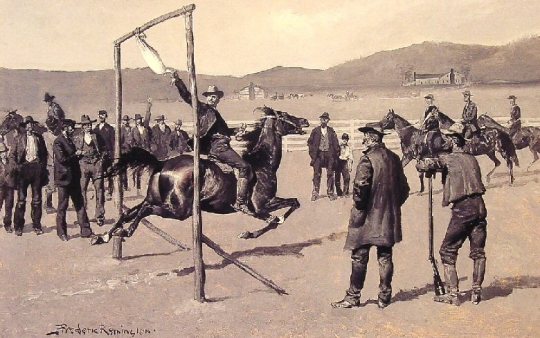
Goose pulling in West Virginia, 19th century
But what is the goose game?
First we have to know that in the Middle Ages, the goose was a symbol of everything bad: failure, plague, war, famine. Oppressed minorities such as agotes were forced to wear a red goose so that the rest would know of their pariah status. The game emerged in this symbolic context.
A live goose was tied by the legs, making it hang upside down from a rope or a pole. The initial objective was to destroy evil, and it is said that towns would pay knights to remove the head of the bird while galloping, either with their hands or with a staff.
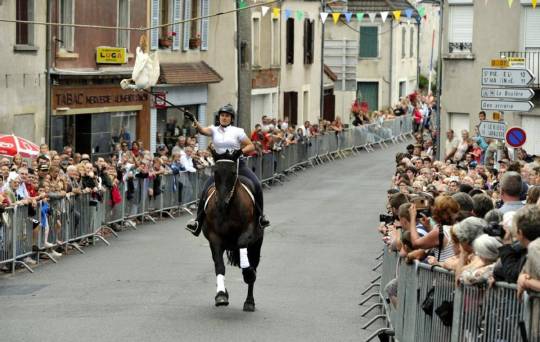
A game using a staff in Arfeuilles (France).
Little by little it evolved into a rite of passage from a child to an adult man, and no one was paid anymore, it was the young men of town who played. Needless to say, the one who actually got the head of the animal won. In EH, Pierre de Lancre banned it because he considered it was an initation to magic.
Of course the game was nothing but torture for the poor goose, so at the beginning of the 20th century it began to be considered cruel and, since its sense as rite of passage had been lost and it was only played during patron saint festivities, its popularity declined very quickly. Today, nowhere in Europe the game is played with live geese.
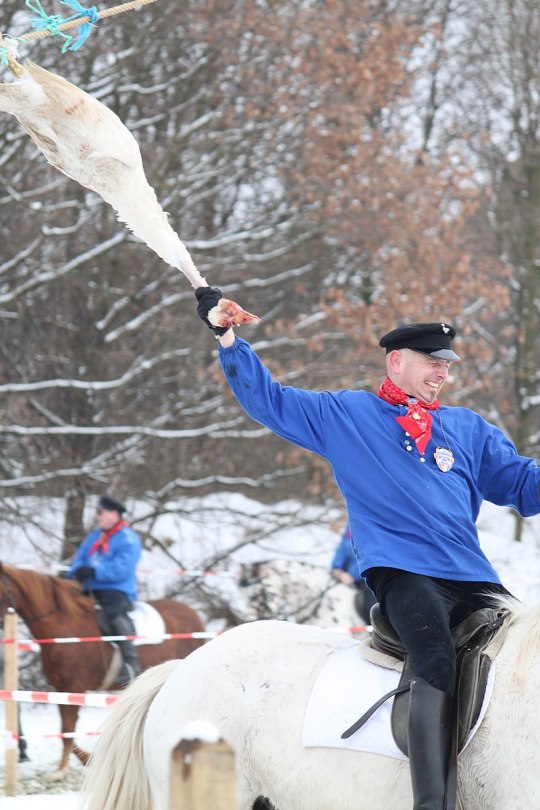

Geese pulling in Höntrop (Germany) and Markina (EH).
In EH the goose game is played every year in September and there are two types of goose pulling: the one practiced in Iparralde (in Sara, Ainhoa, Zuraide, Biriatu and Urruña) and Markina, and the one in Lekeitio, which is unique in Europe. While in Markina and Iparralde the classic game is played on horseback, in Lekeitio - known for its seafaring tradition - it is played from the water.
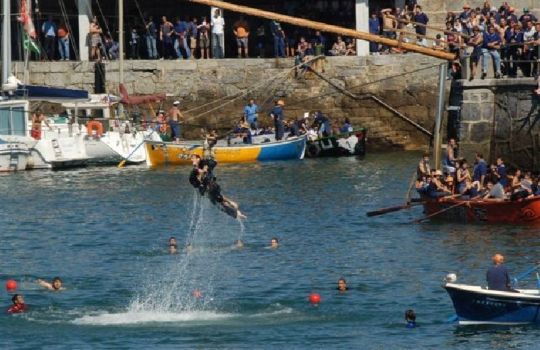
Only in this place in all of Europe the game is not played with real dead geese, but with plastic geese made specifically for the celebration.
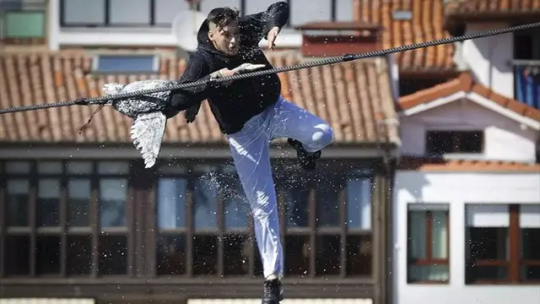
The plastic geese of Lekeitio.
Although played with dead animals everywhere but in Lekeitio - that rejected even dead geese and went for plastic ones -, it's still a controversial game. Should animals die specifically for a human game? Is it moral to destroy their bodies? Is it different from killing and cutting them up for consumption? I'd like to know your take on this ^_^
#euskal herria#basque country#pays basque#pais vasco#euskadi#culture#antzar eguna#goose pulling#game of goose#folklore#europe#lekeitio#iparralde#germany#netherlands#france#usa
28 notes
·
View notes
Photo

16th Century Painting Returned to Heir of Dutch Collector – ARTnews.com
... The latest case is just one of only a few returns that Goudstikker’s surviving relatives have secured. Last year, officials of the German city of Trier restituted a 17th-century Dutch painting by Adam van Breen titled Ice Skating to Von Saher following a legal claim. The painting had circulated at auction in the late 1980s. In 2019, Von Saher attempted to appeal to the U.S. Supreme Court a lower court ruling that allowed the Norton Simon Museum in Pasadena, California, to keep two paintings by Lucas Cranach the Elder once owned by Goudstikker that were illegally taken by Nazis. The appeal came after a long legal battle with the museum for their return, but the Supreme Court declined to take up the case.
The Goudstikker Art Research Project, which oversees restitution claims related to Goudstikker’s property, is currently seeking the return of 800 remaining works illegally exported from Amsterdam to Germany by Nazi officials.
Around 1,100 works looted from Goudstikker’s holdings were taken in Amsterdam by Reichsmarschall Hermann Göring, a high-ranking Nazi official. A portion of the stolen works were eventually returned to the Dutch government, which facilitated the restitution of 200 paintings to the family in 2006, eight years after the family’s initial claim seeking their legal return was denied.
2 notes
·
View notes
Text
Advertise your Business through Dimensional Mailers
New Post has been published on https://wr1tepress.com/advertise-your-business-through-dimensional-mailers/
Advertise your Business through Dimensional Mailers
Are you looking for an effective tactics in advertising your business? Get to know dimensional mailers and how it can help generate consumer response. While the world pays respectful tribute to Rembrandt Van Ryn the artist, it has been compelled to wait until comparatively recent years for some small measure of reliable information concerning Rembrandt Van Ryn the man. Rembrandt Van Ryn was born in the pleasant city of Leyden, but it is not easy to name the precise year. Somewhere between 1604 and 1607 he started his troubled journey through life, and of his childhood the records are scanty. Doubtless, his youthful imagination was stirred by the sights of the city, the barges moving slowly along the canals, the windmills that were never at rest, the changing chiaroscuro of the flooded, dyke-seamed land. Perhaps he saw these things with the large eye of the artist, for he could not have turned to any point of the compass without finding a picture lying ready for treatment.
His family soon knew that he had the makings of an artist and, in 1620, when he could hardly have been more than sixteen, and may have been considerably less, he left Leyden University for the studio of a second-rate painter called Jan van Swanenburch. We have no authentic record of his progress in the studio, but it must have been rapid. He must have made friends, painted pictures, and attracted attention. At the end of three years he went to Lastmans studio in Amsterdam, returning thence to Leyden, where he took Gerard Dou as a pupil. A several years later, it is not easy to settle these dates on a satisfactory basis, he went to Amsterdam, and established himself there, because the Dutch capital was very wealthy and held many patrons of the arts, in spite of the seemingly endless war that Holland was waging with Spain.
His art remained true and sincere, he declined to make the smallest concession to what silly sitters called their taste, but he did not really know what to do with the money and commissions that flowed in upon him so freely. The best use he made of changing circumstances was to become engaged to Saskia van Uylenborch, the cousin of his great friend Hendrick van Uylenborch, the art dealer of Amsterdam. Saskia, who was destined to live for centuries, through the genius of her husband, seems to have been born in 1612, and to have become engaged to Rembrandt Van Ryn when she was twenty. The engagement followed very closely upon the patronage of Rembrandt Van Ryn by Prince Frederic Henry, the Stadtholder, who instructed the artist to paint three pictures.
Saskia is enshrined in many pictures.
She is seen first as a young girl, then as a woman.
As a bride, in the picture now at Dresden, she sits upon her husbands knee, while he raises a big glass with his outstretched arm.
Her expression here is rather shy, as if she deprecated the situation and realised that it might be misconstrued.
This picture gave offence to Rembrandt Van Ryns critics, but some portraits of Saskia remained to be painted.
She would seem to have aged rapidly, for after marriage her days were not long in the land.
She was only thirty when she died, and looked much older.
In 1638 we find Rembrandt Van Ryn taking an action against one Albert van Loo, who had dared to call Saskia extravagant. It was, of course, still more extravagant of Rembrandt Van Ryn to waste his money on lawyers on account of a case he could not hope to win, but this thought does not seem to have troubled him. He did not reflect that it would set the gossips talking more cruelly than ever. Still full of enthusiasm for life and art, he was equally full of affection for Saskia, whose hope of raising children seemed doomed to disappointment, for in addition to losing the little Rombertus, two daughters, each named Cornelia, had died soon after birth. In 1640 Rembrandt Van Ryns mother died. Her picture remains on record with that of her husband, painted ten years before, and even the biographers of the artist do not suggest that Rembrandt Van Ryn was anything but a good son. A year later the well-beloved Saskia gave birth to the one child who survived the early years, the boy Titus. Then her health failed, and in 1642 she died, after eight years of married life that would seem to have been happy. In this year Rembrandt Van Ryn painted the famous “Night Watch,” a picture representing the company of Francis Banning Cocq, and incidentally a day scene in spite of its popular name. The work succeeded in arousing a storm of indignation, for every sitter wanted to have equal prominence in the canvas.
It may be said that after Saskias death, and the exhibition of this fine work, Rembrandt Van Ryns pleasant years came to an end. He was then somewhere between thirty-six and thirty-eight years old, he had made his mark, and enjoyed a very large measure of recognition, but henceforward, his career was destined to be a very troubled one, full of disappointment, pain, and care. Perhaps it would have been no bad thing for him if he could have gone with Saskia into the outer darkness. The world would have been poorer, but the man himself would have been spared many years that may be even the devoted labours of his studio could not redeem.
Between 1642, when Saskia died, and 1649, it is not easy to follow the progress of his life; we can only state with certainty that his difficulties increased almost as quickly as his work ripened. His connection with Hendrickje Stoffels would seem to have started about 1649, and this woman with whom he lived until her death some thirteen years later, has been abused by many biographers because she was the painters mistress.
He has left to the world some 500 or 600 pictures that are admitted to be genuine, together with the etchings and drawings to which reference has been made. He is to be seen in many galleries in the Old World and the New, for he painted his own portrait more than a score of times. So Rembrandt Van Ryn has been raised in our days to the pinnacle of fame which is his by right; the festival of his tercentenary was acknowledged by the whole civilised world as the natural utterance of joy and pride of our small country in being able to count among its children the great Rembrandt Van Ryn.
0 notes
Text
Of the many grim lessons from Russia’s war of conquest in Ukraine, perhaps the grimmest is that 21st-century state-on-state warfare will continue to cause exceptionally high losses of soldiers and equipment. Estimates of military casualties recently passed an estimated 100,000 killed and wounded soldiers for Ukraine and as many as 180,000 for Russia, along with thousands of destroyed tanks, aircrafts, and other major weapons systems. To make matters worse for both Russians and Ukrainians, these losses have disproportionally affected elite units and their most modern gear and equipment.
Consequently, a country’s ability to rapidly reconstitute a military force suffering from such casualties will be a key factor in sustaining any similarly intense state-on-state fight in the 21st century. Notably, the two combatants have not only been able to absorb and replace their horrendous losses, but they have even expanded their forces in the field. Ukraine, for example, started the war with 33 maneuver brigades and has added around nine additional brigades since then. Russia has likely doubled the number of soldiers deployed in the war in the six months since its announcement of mobilization, even if the overall quality of Russia’s force declined.
In part, what enabled the two sides to regenerate forces so rapidly is that they can call on a large pool of reservists generated by a system of mandatory military service that still exists in both countries. According to data from Military Balance+, Ukraine has approximately 900,000 available reservists with active military experience within the last five years, whereas Russia can rely on a 2 million-strong reserve. Russian reservists, however, are mostly inactive—that is, they generally do not participate in any training after their regular active duty. (In 2021, Russia launched a new program meant to expand the combat-capable reserve component, but the start of the war halted recruitment.)
A portion of Ukrainian reservists did get called up for training before the start of the war, but the vast majority of reserves have also been inactive, and their overall quality is mixed. Nonetheless, some of these reservists had plenty of experience as soldiers, including through combat tours in eastern Ukraine, where fighting has been ongoing since 2014. Without mass conscription and its support structures, both sides’ ground forces would be suffering from a massive decline in military capacity at the current stage of this war of attrition. This is not only because it takes much longer to instruct civilians in military basics than retraining former conscripts but also because the existing conscription system provides Ukraine and Russia with at least a rudimentary organizational structure for mobilizing and absorbing large numbers of reservists.
It is thus unsurprising that the war in Ukraine has reignited a debate across much of Europe about military conscription, which most NATO countries suspended in the two decades after the end of Cold War. Among NATO’s 30 European member states, only Denmark, Estonia, and Greece currently require mandatory military service. But Germany’s new defense minister, Boris Pistorius, recently said it was a “mistake to suspend compulsory military service” in the Bundeswehr, Germany’s military. Other German politicians have since followed suit. The Dutch defense ministry has been studying the possible introduction of a conscription-style system, with the debate gaining increasing urgency. Mandatory military service was also an issue during Italy’s general election last year.
While Poland debated and ultimately dismissed calls to reintroduce the draft, conscription resumed in Latvia in January—for the first time since it was suspended in 2007. Denmark, in turn, plans to expand its existing compulsory military service for men to include women as well. When one talks to force planners in select European countries, they say what is partially driving this debate is not just difficulties in meeting recruiting targets but also the realization that even the largest military powers in NATO, such as Germany or Poland, would have a tough time sustaining a casualty rate similar to what Ukraine suffered in the first few weeks of Russia’s invasion while still fielding an effective fighting force.
Reinstating full military conscription may not be the best practical answer for most NATO states to increase hard power. First, it would need to overcome staunch political opposition in much of Europe and would be financially challenging. German Finance Minister Christian Lindner has already called the debate a “discussion about ghosts” while Polish Defense Minister Mariusz Blaszczak sees no need to bring back the draft.
Second, reintroducing military conscription would take time, since it requires a major organizational overhaul of European forces’ current structure to accommodate conscripts. This includes a cadre of new instructors; the construction of new screening, processing, and training facilities; and basic military equipment that would eat up defense budget increases for at least a decade. Third, it is unclear whether a full embrace of the draft would produce the force NATO needs in terms of military effectiveness and combat power in Europe. An expansion of military capacity by increasing force size might leave little room to develop capabilities, such as new technologies and weapons systems, and it could undermine force readiness.
Consequently, instead of returning to full conscription and wasting precious time and resources in restructuring and reorganizing European NATO forces, other ways to help increase Europe’s ability to regenerate combat power during a high-intensity conflict should be examined. The first aspect in this regard is the reserve components of European NATO forces. Every European military has a reserve designed to be called up under national security emergencies, including when there is a danger of impending military conflict, to complement active-duty troops. Among European NATO members, however, the reserve system is in severe need of reform. There are neither enough reservists nor do they train often enough, whereas the training they do receive does not prepare reservists for large-scale, high-intensity warfare like in Ukraine now. (For that matter, not even active-duty forces have proper training in most European NATO countries.)
In a conscript force, the reserve plays a crucial role. Only when they call up reservists do units attain their full fighting strength. For example, the conscription-based Finnish military only has an active-duty force of 19,250 people, of whom only a small nucleus are professional soldiers. But Finland can draw on a reserve of 238,000 people. Every year, two conscription cycles with 9,000 recruits each maintain this mobilization strength for the event of war. The advantage of a force structure built around conscripts is that it enables a steady flow of replacements. It also makes it possible to field a relatively large force for territorial defense. The disadvantage is that the combat readiness of such a force can only be maintained through rigorous training and large-scale exercises. In Finland, 18,000 reservists are called up each year for training, although there can be gaps of up to five years between these programs, significantly reducing their effectiveness.
Professional armed forces, such as those of most European NATO members today, combine long-serving volunteers and shorter-term contractors, and they do not maintain large reserve forces. One reason is that this much smaller force is supposed to be at close to full wartime strength at all times. Reservists, who are also volunteers and have served in the same smaller structure, logically make up a much smaller component than a conscript force. Over the last two decades, force planners in Europe focused on expeditionary, counterinsurgency warfare, such as the conflicts in Afghanistan or Iraq—not large-scale, state-on-state warfare—and did not consider it necessary to maintain large reserves. Nor was it financially feasible to keep a large reserve structure in place: All-volunteer reserves cost significantly more than a conscripts-based force since they must be financially incentivized to serve. Due to civilian job opportunities and the relatively low prestige of soldiering compared to the United States, European militaries have also had a tough time attracting enough volunteers.
As a result, European NATO militaries cannot draw on a pool of reservists big enough to maintain combat effectiveness for very long in any large-scale, high-intensity warfare scenario. For example, less than 10 percent of a tank or infantry battalion’s soldiers who are either killed, wounded, or captured could render the entire unit combat ineffective—with not enough reservists available to refill the ranks. According to data from the International Institute for Strategic Studies’ Military Balance+, France fields an active force of just over 200,000 soldiers, plus a reserve of 41,000 people. Germany has 183,000 troops and a reserve force of a little over 30,000 people. Italy has an active force of around 161,000 people and a minuscule reserve force of 17,900 people, while Poland has around 114,000 active-duty soldiers and a reserve force of about 36,000 people.
Among larger European military powers, only Britain fields a sizable reserve component relative to its active-duty force, with around 153,000 professionals and a 75,000-strong reserve. A major issue is that the reserves in many countries are no longer structurally embedded with active forces. Active units no longer contain entire reserve formations periodically called up for training, which has created a divide between the two components and a lack of expertise in how to integrate and effectively use reserves. There is also no uniform approach for how reservists are used. Some reservists are formed in territorial defense units, others complement existing active-duty formations, and still others temporally fill holes among active-duty personnel.
In addition to the small size of reserves, training is a major issue. No large European country, except perhaps Britain and Poland, has a system like the United States’, with its large U.S. National Guard and reserve forces, which exercise frequently and regularly, typically at least once per month along with one two-week period each year. Neither the German Bundeswehr nor the Italian Army regularly calls up reserves for training and exercises. In France, reservists are theoretically required to train at least 10 days per year. However, even when some units are called up for longer periods than this, it does not mean that any training for large-scale combat operations takes place. Rather, reservists could be called up to help protect military installations or patrol streets, with little to no time spent on improving combat skills. In Spain, reservists serve a maximum of seven days per year, although these seven days can be stretched out over a period of three years depending on the unit and service branch. In Britain, depending on the service branch and one’s specialization, annual training averages 27 days. In Poland, the reserves making up the Territorial Defence Forces are called up for one weekend each month, in addition to a two-week period every year, although the quality of training in these units can vary widely.
Beyond limited training time, another issue is the limited size and scope of exercises at both national and NATO levels, especially for European ground forces. Full brigade-size exercises involving reserve units are the exception, not the rule—although this is gradually changing. Larger exercises at the division or corps-level are practically nonexistent outside command post exercises, where staff officers simulate large-scale operations on maps and computers with no actual troops in the field. Reservists, except for those of the exercise’s host country, are generally also not included in large numbers in NATO exercises. The absence of large-scale training exercises for high-intensity combat is a major problem across all European NATO militaries. As one analyst put it: “Without being able to physically practice the co-ordination required for large-scale maneuvers, and experience the friction of war, our understanding of warfare is becoming increasingly theoretical, without the practical grounding necessary to test our doctrine.” Reinstating conscription might help raise the number of reservists, but it would not address these training deficits.
What needs to be done?
First, the size of reserve forces across European NATO militaries will need to undergo structural reorganization to be able to increase in size. Reserves should no longer primarily be used as piecemeal to plug gaps and fill troop shortages in active-duty forces but be more actively integrated and more uniformly trained to support high-intensity combat operations. This is the basic prerequisite for reserves to be capable of replacing active-duty personnel put out of action in a worst-case scenario. One way to do this would be to create more hybrid units consisting of active and reserve soldiers in addition to pure reserve units. When it comes to the manpower issue, one way to address it is to require all active-duty troops to serve in the reserves for a few years once their contracts are up. Some countries, such as France, are already looking into doubling the size of their reserve and making such reforms. Poland is also in the process of expanding its reserve force, the Territorial Defence Forces, but with mixed results thus far. And while there have been repeated calls in Germany to reform the reserves, including a new strategy announced in 2019, very little has changed.
Second, the scale, scope, frequency, and length of military exercises will have to increase. European NATO militaries will need to introduce more rigorous training schedules modeled on the U.S. reserve system and National Guard. Today’s situation—where there is perhaps one mandatory exercise every other year, every five years, or never at all—is clearly not sufficient to maintain military proficiency. At the same time, exercises need to become larger and more complex. The war in Ukraine has shown that large-scale conventional military operations are difficult to execute and so prone to friction that they cannot be adequately simulated in a synthetic training environment or tabletop exercise. France will be one of the first European countries to hold such a large-scale, divisional-level military exercise: Exercise Orion, involving around 10,000 troops, is scheduled for this spring and will include reservists. Poland plans to call up 200,000 inactive reservists for various training exercises. Other countries need to follow suit. These exercises, above all, need to hone skills in combined arms operations—a deadly game of rock, paper, scissors in which the “strengths of one platform or weapon systems supplements the strengths and weaknesses of another,” as I’ve written elsewhere. Proficiency in combined arms operations can help reduce casualties. One reason why both Russia and Ukraine have suffered so tremendously is because neither military has been capable of executing such combined arms operations effectively at scale.
Finally, to facilitate quick force generation for a high-intensity war in Europe, technology will become an ever more important part of the solution over the coming years and decades. In particular, the proliferation and integration of crewed and uncrewed ground and air systems as envisioned in, for example, the German-French-Italian Main Ground Combat System or the German-French-Spanish Future Combat Air System, could help substitute soldiers with uncrewed systems, act as force multipliers, and take over more dangerous missions in a high-intensity conflict. That will help reduce casualties. Technology, however, will not be a panacea. Organizational, structural, and doctrinal reforms will need to happen as well.
Conscription will not be the solution to help Europe’s leading militaries regenerate combat power in a future state-on-state war. Not only would it be financially draining, but it would also require a major restructuring that would leave these forces vulnerable for some years to come. Rather, reforming and expanding the reserve system could be financially less burdensome, politically easier to implement, and militarily more effective. Reforming the reserve would help increase European NATO members’ staying power in any future high-intensity war against another major military power. And according to the logic of deterrence, it would help reduce the chances of military conflict in the first place.
1 note
·
View note
Text
Copper Butterflies
This is by no means all Copper butterflies as I believe there are sixteen species at the very least.
Number one : Large Copper

The picture above is a male. Females have slightly less bright orange background colour to the forewings, with dark spots and a border. The underside of the wings are grey and spotted.
This species was once widespread among Europe but has become increasingly scarce in central and eastern Europe. In western Europe, it still persists in scattered populations in France and the Netherlands. The British form was once fairly widespread in the wetlands of East Anglia, but has been extinct ever since 1864.
It inhabits various types of wetland, including fens and marshes, wet meadows, and borders of lakes and rivers. In the fens of Eastern England, it was associated with traditional practices of peat and reed-cutting, but it became extinct in the middle of the nineteenth century as these practices died out and the fens were drained for arable agriculture.
Attempts to introduce the similar Dutch subspecies to England were successful for quite long periods, while conservation management in the Netherlands seems to have atleast halted the decline of the butterfly.
Number two : Small Copper

The underside of the wings are pale and scattered with darker spots. Whilst the picture above has black spots, others may have blue spots.
This butterfly is one of the most familiar and widespread of all butterflies in Europe, strangely it is not seen in large parts pf central Sweden and Norway, but its quite widespread further north. In Britain and Ireland, they are found everywhere except the uplands of northern England and Scotland.
They find home in dry grassland and heaths with well-drained soils. They are also found on coastal dunes, worked-out sand quarries, roadside verges and urban brownfield sites, usually sparsely vegetated with patches of bare ground.
Males perch prominently and actively challenge passing insects, including females of their own species, which they pursue with a very rapid flight. Females are less active, and lay their eggs on food plants of their caterpillars, either common sorrel or sheep's sorrel, depending on availability.
Number three : Purple-edged Copper

The picture above is a male. Females are brown with vague areas of dull orange towards the middle of the forewings and rows of faint dark spots. The underside of the wing is grey with black spots and a band of orange.
This butterfly is widespread in suitable habitats throughout most of Europe. However, it is not found in Britain, Ireland and northern France.
They favour damp, flowery meadows where the food plants of its caterpillars (sorrel and various docks) grow. Like many meadow species, it is threatened by the spread of intensive agriculture, especially in lowlands.
Number four : Violet Copper
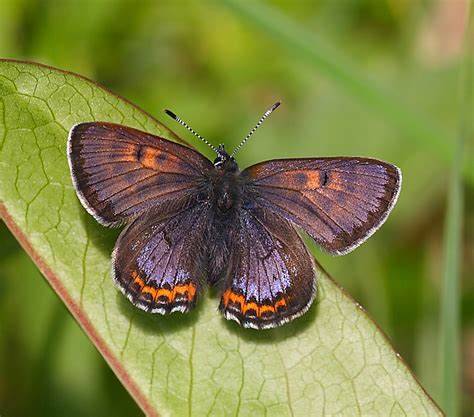
The picture above is female. Females have slightly more purple than their male counterparts.
This rare and beautiful species has only scattered populations in Western Europe, but is more widespread in central and northern Europe, extending northwards to central Sweden , Norway and Finland. It is absent from Britain and Ireland.
It inhabits humid meadows, moist glades, and open banks along streams and bogs in woodland, where the food of the caterpillars grow in abundance. They settle, often with wings open, on leaves of bistort, or take nectar from its flowers.
The females lay their eggs on leaves of bistort or alpine bistort in the north of their range. These butterflies emerge in May, and can be seen until the middle of June. This species is seriously threatened throughout Europe due to drainage and changes in forestry management.
Number five : Purple-shot Copper

This butterfly has several distinct form is different parts of Europe, but the typical form of males in the northern part of its range looks like the picture above with the orange background and black spots, all suffused with violet scales.
It is widespread in southern, central and eastern Europe, but is absent from or vary rare in the north-west. It reaches the northern limit in the Baltic states, where it is very localised. It is absent from Britain, Ireland and Scandinavia.
It inhabits flower-rich meadows, sheltered hollows in hillsides and sometimes open woodland clearings and roadside verges. These butterflies are active, taking nectar from meadow flowers such as ox-eye daisy, and fly in one annual generation from June to the end of July. The caterpillars feed on leaves of sorrels aswell as other plants in the dock family, and have strong associations with ants.
Number six : Sooty Copper
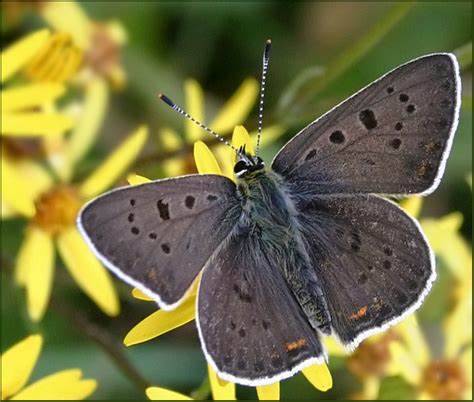
The picture above is a male. Females tend to be similar to males but usually have a more prominent orange border. The underside wing ground colour is fawn or slightly yellowish-brown with black spots, and a black-bordered row of orange lunules along the wing borders. Their wing shape is distinctive with a rather pointed tip to hindwing and relatively narrow forewings, especially in males. Their appearance is quite variable, tending to be darker further north and at high altitudes.
They are widespread and common in most of Europe, reaching north to Denmark and the Baltic states, and apparently now extending its range northwards into southern Finland. It is absent from the rest of Scandanavia, Britain and Ireland.
They're found in dry meadows, open glades in woodland, scrubland and other flowery places where the caterpillars food plant grows. There are just two flight periods, from mid-May to mid-June and again from mid-July to early September. Their eggs and laid on sorrel and probably other plants in the dock family.
1 note
·
View note
Text
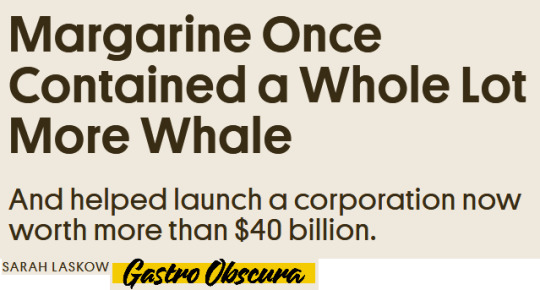
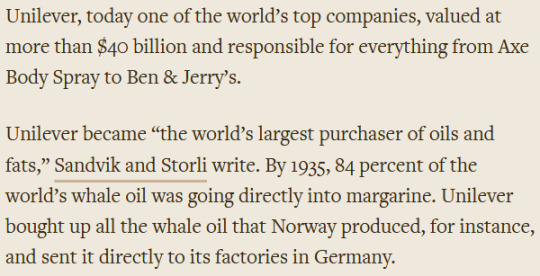
----------

----------


----------
Here are some images and text published by: Sarah Laskow. “Margarine Once Contained a Whole Lot More Whale.” Gastro Obscura. 11 October 2018.
Once, the homes and streets of Europe were lit with whale oil, burning bright but smelling awfully fishy. In the 19th century, the whaling industry was a major force in the world’s energy markets, until oil wells started shooting up in Pennsylvania. As petroleum began to boom and kerosene became a popular lamp fuel, the world had surplus of whale oil, looking for a new market.
It went to the makers of margarine.
Margarine was invented in 1869, just as whale oil was on the verge of falling out of use as a fuel. To simulate butter, margarine must contain some kind of fat. That might come from a variety of vegetable oils -- as in most margarines today -- or beef fat. But in the first half of the 20th century, since whale oil was “no longer needed for illumination” and a “large amount became available,” as one researcher wrote in the 1960s, most of the world’s supply was being whipped into a spreadable butter substitute. [...]
[T]he whale oil industry poured its product into margarine, creating, in the process, a multinational company now worth billions of dollars.
French inventor Hippolyte Mege-Mouries first made margarine because there was money in it. Napoleon III, eager for a lower-cost replacement for butter -- some sort of luxurious everyday fat for the lower classes and the military -- offered a tempting cash prize to anyone who could come up with one. [...]
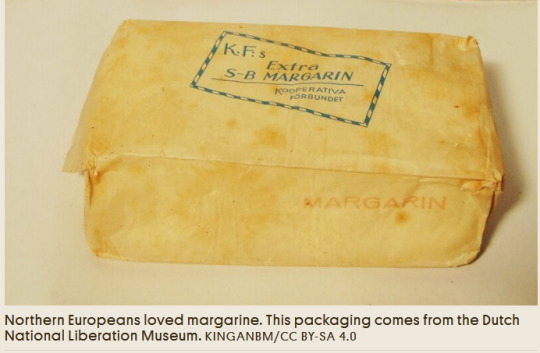
The French did not exactly take to this new product, but it grew popular in other parts of Europe. “Before World War I, the manufacture of margarine exceeded that of butter in England and Scotland,” Epste!n notes in her book, The Power of Words in International Relations: Birth of an Anti-Whaling Discourse.
“Nobody ate more margarine per capita than the Danes, Norwegians, and Swedes,” according to Norwegian historians Pal Thonstad Sandvik and Espen Storli. In Britain, margarine reached peak consumption per person in 1929 and 1930, while in Germany, per capita consumption of margarine was close to 17.5 pounds year in 1930. At that time, as The History of Modern Whaling reports, whale oil was “the cheapest of all edible oils” -- a natural economic choice for margarine production. [...] On top of the declining market for other uses of whale oil, the whaling economy was very volatile, which led to surpluses. “It’s quite easy to turn a big boat into a whaling boat. As soon as the price of whale oil would start shooting up, everyone would get into whaling,” says Epste!n. [...]

Margarine manufacturers swept in to buy it up at low prices. In 1929, as Epste!n writes, two companies -- Lever Brothers, a British firm, and Margarine Unie, a Dutch company -- discovered how to improve the chemical process used to harden whale oil into a margarine ingredient. As a result, margarine could be made with whale oil as its only fat. Rather than competing, the companies quickly merged and became Unilever, today one of the world’s top companies, valued at more than $40 billion and responsible for everything from Axe Body Spray to Ben & Jerry’s.
Unilever became “the world’s largest purchaser of oils and fats,” Sandvik and Storli write. By 1935, 84 percent of the world’s whale oil was going directly into margarine. Unilever bought up all the whale oil that Norway produced, for instance, and sent it directly to its factories in Germany. [...]
As tensions in Europe increased, though, whale oil became an increasingly contested commodity. In the years leading up to the war, the product had become a major part of the food supply in Britain, and in 1938 the British government named it a “national defense” commodity. [...] But once the war was over, the importance of whale oil in margarine production began to decrease [...] The whaling industry crashed so badly that General Douglas MacArthur encouraged Japan to buy up boats for cheap and start up a whaling economy there. At the same time, margarine producers had figured out how to make it cheaply with vegetable oil [...].
[End of excerpt.]
-------
From elsewhere:
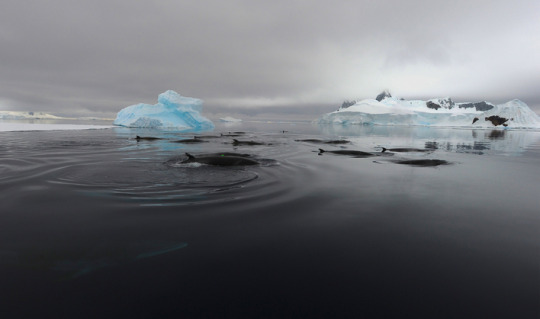
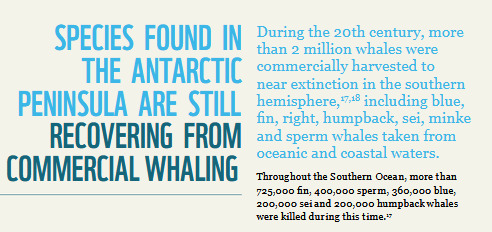
Text reads: “Species found in the Antarctic Peninsula are still recovering from commercial whaling. During the 20th century, more than 2 million whales were commercially harvested to near extinction in the southern hemisphere, including blue, fin, right, humpback, sei, minke and sperm whales [...]. Throughout the Southern Ocean, more than 740,000 fin, 400,000 sperm, 360,000 blue, 200,000 sei and 200,000 humpback whales were killed during this time.”
Image and text published by: Whales of the Antarctic Peninsula -- Science and Conservation for the 21st Century. A report for policymakers from University of California, Santa Cruz and WWF. 2018.
291 notes
·
View notes
Text
📷
Michael Yon@MichaelYon 📷4 hours ago
Afghanistan SITREP
From sourceOCC, 12:00 AMWestern nations race to complete Afghan evacuation as deadline loomsWestern nations rushed to complete the evacuation of thousands of people from Afghanistan on Wednesday as the Aug. 31 deadline for the withdrawal of foreign troops drew closer with no sign that the country's new Taliban rulers might allow an extension.In one of the biggest such airlifts ever, the United States and its allies have evacuated more than 70,000 people, including their citizens, NATO personnel and Afghans at risk, since Aug. 14, the day before the Taliban swept into the capital Kabul to bring to an end a 20-year foreign military presence.U.S. President Joe Biden said U.S. troops in Afghanistan faced mounting danger and aid agencies warned of an impending humanitarian crisis for the population left behind.Biden said they were on pace to meet the deadline, set under
an agreement struck with the Islamist group last year to end America's longest war."The sooner we can finish, the better," Biden said on Tuesday. "Each day of operations brings added risk to our troops."Two U.S. officials, speaking on condition of anonymity, said there was growing concern about the risk of suicide bombings by Islamic State at the airport.British foreign minister Dominic Raab said the deadline for evacuating people was up to the last minute of the month.Tens of thousands of Afghans fearing persecution have thronged Kabul's airport since the Taliban takeover, the lucky ones securing seats on flights.Many people milled about outside the airport - where soldiers from the United States, Britain and other nations were trying to maintain order amid the dust and heat - hoping to get out.They carried bags and suitcases stuffed with possessions, and waved documents at soldiers in the hope of gaining entry. One man, standing knee-deep in a flooded ditch, passed a child to man above."I learned from an email from London that the Americans are taking people out, that's why I've come so I can go abroad," said one man, Aizaz Ullah.While the focus is now on those trying to flee, the risk of starvation, disease and persecution is rising for the rest of the population, aid agencies say.1/4A U.S. Marine with the Special Purpose Marine Air-Ground Task Force-Crisis Response-Central Command (SPMAGTF-CR-CC) escorts a child to his family during an evacuation at Hamid Karzai International Airport in Kabul, Afghanistan,"There's a perfect storm coming because of several years of drought, conflict, economic deterioration, compounded by COVID," David Beasley, executive director of the U.N. World Food Programme, told Reuters in Doha, calling for the international community to donate $200 million in food aid."The number of people marching towards starvation has spiked to now 14 million."The EU said this week it was planning to quadruple aid and was seeking coordination with the United Nations on delivery as well as safety guarantees on the ground.The U.N. human rights chief said she had received credible reports of serious violations by the Taliban, including "summary executions" of civilians and Afghan security forces who had surrendered. The Taliban have said they will investigate reports of atrocities.The Taliban's 1996-2001 rule was marked by harsh sharia law, with many political rights and basic freedoms curtailed and women severely oppressed. Afghanistan was also a hub for anti-Western militants, and Washington, London and others fear it might become so again.LAND ROUTESA NATO country diplomat in Kabul, who declined to be identified, said several international aid groups were desperate to get Afghan staff out and neighbouring countries should open their land borders to allow more people to leave."Iran, Pakistan and Tajikistan should be pulling out far more people using either air or land routes. It's vital air and land routes are used at a very fast pace," the diplomat told Reuters.The Taliban said all foreign evacuations must be completed by Aug. 31, and asked the United States to stop urging talented Afghans to leave, while also trying to
persuade people at the airport to go home, saying they had nothing to fear."Foreign troops should withdraw by the deadline. It will pave the way for resumption of civilian flights," Taliban spokesman Suhail Shaheen said on Twitter."People with legal documents can travel through commercial flights after Aug. 31."The Dutch government, echoing some other governments, said it was all but certain that many people eligible for asylum would not be taken out in time.Dutch troops had managed to get more than 100 people to Kabul airport, Foreign Minister Sigrid Kaag said, but hundreds of others risked being left behind.The U.S.-backed government collapsed as the United States and its allies withdrew troops two decades after they ousted the Taliban in the weeks after the Sept. 11, 2001, attacks on the United States by al Qaeda, whose leaders had found safe haven in Taliban-ruled Afghanistan.Taliban leaders have begun talks on forming a government.OCC, 1:45 AMWhat Will the Taliban Do With Their New US Weapons?With its quick seizure of power, the Taliban also acquired U.S. military equipment left behind by the withdrawal or abandoned by Afghan forces.What Will the Taliban Do With Their New US Weapons?
Capturing the enemy’s weapons has been a standard guerrilla tactic for centuries. The American Army could not have succeeded against King George III without seizing the king’s food and armaments. It is one thing to capture weapons and other materiel; it is another to be given the enemy’s gear on a silver platte
In the images of the Taliban fighters flooding the streets of Kabul, one detail attracts attention: the lack of the ubiquitous Kalashnikov. Few Taliban appearing now carry the signature weapon of insurgent fighters, the AK-47, and its countless variants from the handmade PakistaniA Taliban fighter stands guard at a checkpoint in the Wazir Akbar Khan neighborhood in the city of Kabul, Afghanistan, Sunday, August 22, 2021.Capturing the enemy’s weapons has been a standard guerrilla tactic for centuries. The American Army could not have succeeded against King George III without seizing the king’s food and armaments. It is one thing to capture weapons and other material; it is another to be given the enemy’s gear on a silver platter.
In the images of the Taliban fighters flooding the streets of Kabul, one detail attracts attention: the lack of the ubiquitous Kalashnikov. Few Taliban appearing now carry the signature weapon of insurgent fighters, the AK-47, and its countless variants from the handmade Pakistani versions to the updated Russian AK-19. Most of the Taliban in Kabul’s street seems to prefer American M4 carbines and M16 rifles with their many gadgets attached, from expensive optics to laser sights and flashlights, an uncommon picture in contrast to just a few weeks earlier.
The answer to the question concerning the source of these small arms is straightforward: war looting. Another and more important question needs an answer: The fate of the extensive military materiel that the U.S. left behind during its withdrawal or that which was in the hands of the Afghan forces that melted so quickly away as the Taliban advanced.
As a landlocked country, Afghanistan makes moving military materiel back to the U.S. neither an easy nor an economical endeavor. Much was removed anyway, and much handed over to Afghan government forces. What couldn’t be taken back, was left. Blowing up in situ large quantities of war materiel is cheaper than shipping it out of Afghanistan. Still, that option creates toxic legacies that would affect the local population for a long time, as happened in Iraq.
Nevertheless, lack of time and unreasonable expectations on the survivability of the Afghan security forces caught the Pentagon by surprise. According to Joshua Reno, author of “Military Waste: The Unexpected Consequences of Permanent War Readiness,” recirculating weapons in the places a military force leaves when the battle is over will augment the risks that small arms or other weapons are going to fuel and intensify civil war or instability.
According
to a top Pentagon logistics specialist, there is no clear record of the quantity and quality of military equipment left behind. National Security Adviser Jake Sullivan stated that the Taliban probably would not give such materiel back to the U.S. at the airport, adding a note of farce to an already disastrous situation. One of the immediate conclusions drawn from the less-than-optimal U.S. military withdrawal from Afghanistan is how the U.S. can minimize the chances of future disasters stemming out of the Taliban’s use and trade of abandoned U.S. and Afghan military materiel.
U.S. military and intelligence had already walked that path in the 1990s, after the anti-Soviet mujahedeen pushed out the Soviet Union. The task at that time was to recover Stingers, highly sophisticated portable surface to air missiles. In order to have a chance against the Soviet Union’s heavily armed attack helicopter Mil Mi-24, essentially a flying tank, the U.S. had equipped the mujahedeen with Stingers in the 1980s. As soon as the war ended with the Soviet defeat, the possibility of those Stingers being employed for terrorist attacks or falling into hostile government hands ignited a hunt to get the portable missiles back. The U.S. intelligence community scrambled to buy them back, allegedly at $100,000 per unit, or obtain the portable missiles by any means. Steve Coll in his acclaimed book “Ghost Wars,” mentioned that when the Taliban seized Kabul in 1996, an estimated 600 of the 2,300 Stingers provided by the CIA during the Soviet-Afghan war remained unaccounted for. Tehran was competing in the same race to acquire as many of the wayward Stingers as possible.
Providentially, the threat of a terrorist using a Stinger to shoot down an American passenger plane did not materialize, nor did the Taliban develop a successful insurgent anti-aircraft campaign with the leftovers.
And yes, history repeats itself.
Today’s quantity and quality of weapons that the Taliban are hoarding since their lightning advance will arguably have unintended negative consequences far from Afghan borders. Sales to hostile governments and on the black market may provide additional revenue to the Taliban and increase uncertainty and instability not only in Central Asia but beyond. Militant organizations such as the Haqqani network, already in Kabul, possess the capability to smuggle weapons from Afghanistan to the Middle East, the African continent, and even to Southeast Asia.
Possible scenarios range from small arms used to foster instability in the region or night vision goggles and military-grade communication equipment reaching other militant groups, including the Islamic State. More significant items now in the hands of the Taliban, such as helicopters, can neither be maintained nor flown due to a lack of Taliban pilots and trained maintenance crews. The materiel, however, could be handed over to countries interested in sensitive U.S. technology, and that list is not short. The war looting includes armored Humvees, aircraft, and attack helicopters, as well as military scout drones. Most of the Afghan Air Force’s aircraft were used by Afghan pilots to escape into neighboring Central Asian countries as Kabul fell, but the number still parked on Afghan airfields is unknown.
The fall of Kabul, predictably, has been compared with the fall of Saigon. Most of the analogies point to helicopters leaving the roof of the American Embassy. However, another analogy worth referencing is related to the North Vietnamese political commissars’ scrambling to reach the ARVN and South Vietnamese police’s archives to locate the list of intelligence officials and collaborators. In an era of Big Data and databases stored in the cloud, there is a sudden realization that deleting data from the servers and smashing hard drives is not a bulletproof solution. Moreover, there are severe concerns that hundreds of military biometric devices, abandoned in U.S. bases, left a digital breadcrumb trail that the Taliban will use to locate and target former security officials and government supporters.
Handheld Interagency Identity Detection Equipment, in short HIIDE, devices are meant to digitally identify friends from foes via a biometric reading, against databases with fingerprints, iris scans and distinctive facial features.
Similarly, social media users in Kabul left a digital trail not only on their mobile phones but also on the internet. It’s now digital proof that can be used against them when the Taliban feels confident of their grip on power and local media control. Discounting the Taliban’s capabilities in accessing actionable digital intelligence could be a mistake. Besides the probable support that the Taliban could receive from foreign intelligence services, it is not wise to disparage the ingenuity of militant groups in harnessing low-tech schemes to counter high-tech weaponry. An example is provided by the case of pro-Iranian militants in Iraq using $26 off-the-shelf software to intercept live video feeds from U.S. Predator drones, potentially providing them with information they need to monitor the unblinking eyes of U.S. drones.
The threat of insurgents intercepting drone video feeds has been patched with encrypted communication; however, examples of low-tech tactical efficiencies abound. Since a decade ago, the Taliban have been using off-the-shelf commercial drones to shoot propaganda films and provide aerial scouting and to guide kamikaze flying bombs. This is a playbook borrowed by Islamic State in Syria and Iraq. The recent Taliban capture of Boeing ScanEagle drones, developed for surveillance, could add a new capability to the fighters’ growing arsenal. Also, their tactical use could evolve into alternative and deadly options.
From a propaganda perspective, the videos of Taliban fighters parading in Afghan cities with their U.S. war trophies increase the criticism of the Biden administration’s withdrawal decision. Although it remains unclear how the Taliban will govern Afghanistan, the propaganda value of their white flags waving in the wind from the top of U.S.-made Humvees inspires other jihadist and radical Islamist groups to imitate the Taliban’s actions. The perception of augmented combat capabilities provided by the war looting could also push Central Asian countries to strengthen their bilateral security ties with Moscow and Beijing, no matter what, in the face of a Taliban with modern equipment.
Sun Tzu, the revered author of the “Art of War,” quoted shoulder to shoulder with von Clausewitz in contemporary Western military PowerPoint presentations, states that the golden rule is to know your enemy. Probably 20 years were not enough.OCC, 2:55 AM
Biden, Stoltenberg
7 notes
·
View notes
Text
The Conjuring 2: The Real Story of the Demonic ‘Nun’ Valak
https://ift.tt/3dP4LKr
The Conjuring 2 depicts the demon Valak as some horrific rendition of Cheech and Chong’s Sister Mary Elephant. But this Grand President of Hell is more cherub than dragon in the demonic hierarchy.
As the 62nd spirit in a 72-demon roster, Valak is no delinquent, although he’s been blamed for the two 1212 Children’s Crusades to the Holy Land, which resulted in thousands of teenagers from Germany and France being sold into slavery. Valak also retroactively gets the rap for the 1284 Pied Piper missing children incident in the German village of Hamelin.
The majority of what we know about Valak comes from the mid-17th century Goetic grimoire The Lesser Key of Solomon, a compilation of centuries’ worth of texts. Samuel Liddell MacGregor Mathers translated the works for the Hermetic Order of the Golden Dawn, a late 18th-century magical order. They were published by the notorious English occultist Aleister Crowley as The Book of the Goetia of Solomon the King in the 20th century. Crowley added invocations, along with essays describing the rituals as psychological exploration. According to legend, the demons featured in the grimoire were the ones summoned by the King Solomon character in the Bible.
“The Sixty-second Spirit is Volac, or Valak, or Valu,” reads The Lesser Key of Solomon. “He is a President Mighty and Great, and appeareth like a Child with Angel’s Wings, riding on a Two-headed Dragon. His Office is to give True Answers of Hidden Treasures, and to tell where Serpents may be seen. The which he will bring unto the Exorciser without any Force or Strength being by him employed. He governeth 38 Legions of Spirits.”
Valak first appeared in written form in Pseudomonarchia Daemonum (The False Monarchy of Demons”). The text was an appendix in the 1577 grimoire De praestigiis daemonum (“On the Tricks of Demons”), by Johann Weyer, who himself was a Dutch physician, renowned occultist, and demonologist. That book listed 69 demons along with the proscribed rituals to conjure them. The 72 Shemhamphorasch angelic names and seals came from the 1583 manuscript Le Livre des Esperitz (“The Office of Spirits”) by Blaise de Vigenère, and a now-lost work by Johannes Trithemius.
Valak has several names and titles, depending on the manuscripts and the translation. The spellings of the demon’s moniker range from Ualac to Valu, and Doolas to Volach in Munich Manual of Demonic Magic. A 1577 grimoire called the Book of Oberon lists a demon named Coolor, which is believed to be another name for Valak. This informed Reginald Scott’s influential 1584 grimoire, The Discoverie of Witchcraft.
Valak’s ranking is mainly listed as a “president,” but some manuscripts ranked him as a prince. Don’t let the titles fool you, every demon is called a duke, a king, or a prince. As a Lesser Key demon, Valak leads 38 legions of demons, though the number is also put at 30 and 27 legions of spirits, depending on the manuscript.
The classical iconography of Valak is based on the ancient Greek deity Hermes, whose counterpart in the Roman Mythology was Mercury. Hermes is often depicted as wielding a staff called the caduceus, which is made up of two entwined serpents. The grimoires repurpose that into the two-headed dragon. The two-headed Dragon also has Hindu connotations because it symbolically refers to the arousal of Kundalini, represented by the fire snake. This is believed to be the origin of Valak’s association with snakes.
Humans have six categories for demons, according to Weyer’s Pseudomonarchia Daemonum: Empyreal, Aerial, Subterranean, Aqueous, Terrene, and Lucifugi, which means nocturnal. Angels reportedly recognize only two categories: Apokomistai, which are older, and Nekudaimones, which are younger and weaker. In order to take human form, a Nekudaimone has to possess a human or animal. An Apokomistai can take any form. Valak is an Apokomistai. When summoned, he reputedly appears as a child who uses innocence to lure victims to bad ends. This reputation led to the association with the Children’s Crusades, and the 130 children of Hamlin who went missing on June 26, 1248, even though there were no reports of demons at the time.
Investigators also found no demonic activity at the heart of the events behind The Conjuring 2. Instead they blamed the Enfield Poltergeist, according to the book This House is Haunted by Guy Lyon Playfair. The famous paranormal experts Ed and Lorraine Warren showed up unannounced in the British countryside and were dismissed from the property. They were there for a matter of minutes. That wasn’t the only disparity.
Valak is a male Demon and does not manifest in any female form. In full evocation, he anecdotally appears as a very pale man with black hair and dark eyes. There is no lore that has ever portrayed Valak as a nun. Director James Wan got the Nun character from a vision Lorraine Warren, played by Vera Farmiga in The Conjuring films, claimed she saw of a hooded entity in a swirling tornado vortex. Wan initially loved the CGI possibilities, but ultimately scaled it down to holy iconography. The Nun wasn’t even added to The Conjuring 2 until reshoots, Wan told Gizmodo. The Nun is played by Bonnie Aarons, who also donned the habit in Annabelle: Creation.
In The Conjuring 2, the Nun seems to be stalking Lorraine Warren. Not only does she see the Nun at the Amityville house, and in Enfield, England, but the demon also appeared at the Warren’s home before the investigations. While some viewers may see this as foreshadowing, the character was also angling for a solo feature.
Unlike The Conjuring films, The Nun (2018) was not inspired by a true story but by the 1986 movie The Name of the Rose, based on the book of the same name by Italian author Umberto Eco. That film starred Sean Connery as Friar William of Baskerville. Christian Slater played his apprentice. They investigate the mysterious death of a famous monk who lived in Benedictine abbey in Northern Italy. The monk was found dead in a vat of pig blood and the villagers blame the Devil. Taking a cue from Van Halen, The Nun runs with it.
Valak is seen as something more than a possessive force. Possessions are rare, and often part of a bargaining process. Believers might call it “the fine print.”
Read more
Movies
Hereditary: The Real Story of King Paimon
By Tony Sokol
Movies
The Conjuring Timeline Explained: From The Nun to Annabelle Comes Home
By Daniel Kurland
Valak is a heavily petitioned demon. He is used for curse works like revenge but is also thought to help find money through random events. He is who you call on when you want a raise or promotion, an inheritance, or before financial negotiations. Valak doesn’t work for free, however, and “Demonic Magick” demands certain sacrifices. Luckily, Valak is partial to licorice, as well as gin, knives, coins, and public proclamations in his name. He does not respond to sexual offerings or blood. Summoning Solomonic spirits is traditionally done through ceremonial magic.
Old grimoires are written from a Christian point of view, and the rituals are invocations. In the Middle East, Valak is a Djinni, known to us in the west as genies. Like Aladdin! The djinn are supernatural creatures in early Arabian mythology and theology during the Pre-Islamic period. The djinn were not immortal but were feared because they brought disease and madness. The 72 spirits represent 72 psychological pathologies of the unconscious mind. Djinn are summoned through evocation, allowing the Djinn to be redeemed.
According to an adept practitioner we spoke with, who declined to be named, organized religions demonize Valak and other Lesser Demons, in part, because they “imparted wisdom via the use of astrology. Which is an excellent tool that has ancient roots in all of mankind. It enlightens and empowers people which is exactly what organized religion wants to suppress.”
But before you go rubbing any lamps with licorice sticks, the unnamed Goetic warns, “Wisdom is imparted, but not without a price. You have to really be empowered and very stable and sure of yourself if you want to work with them versus letting them control or overpower you. They do have a maleficent nature; however, without darkness light doesn’t exist either.”
The Conjuring 2’s Valak is a fun film creation. You don’t have to be Catholic to be scared of nuns. Cherubs, not so much. Even on a dragon with two heads, the image is far too accessible to convey what Wan needed. There are so many more horrid descriptions of angels and demons found in religious texts than Valak. But be assured, you never want to take candy from this baby.
cnx.cmd.push(function() { cnx({ playerId: "106e33c0-3911-473c-b599-b1426db57530", }).render("0270c398a82f44f49c23c16122516796"); });
The post The Conjuring 2: The Real Story of the Demonic ‘Nun’ Valak appeared first on Den of Geek.
from Den of Geek https://ift.tt/2MuVhZB
4 notes
·
View notes
Photo
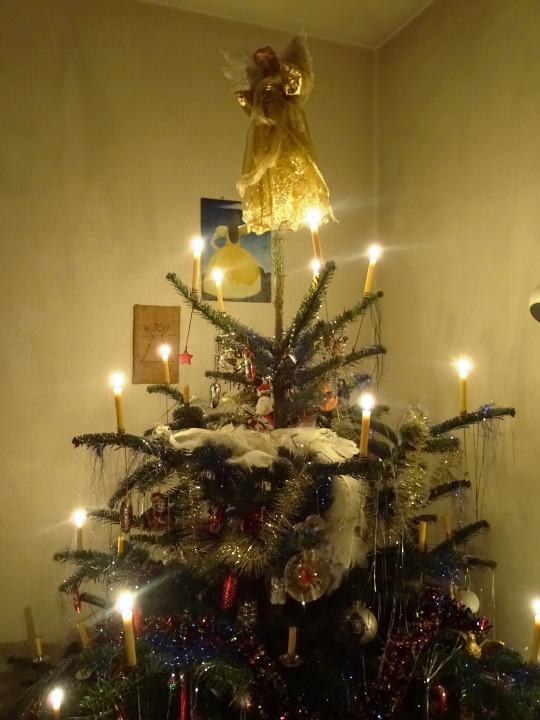

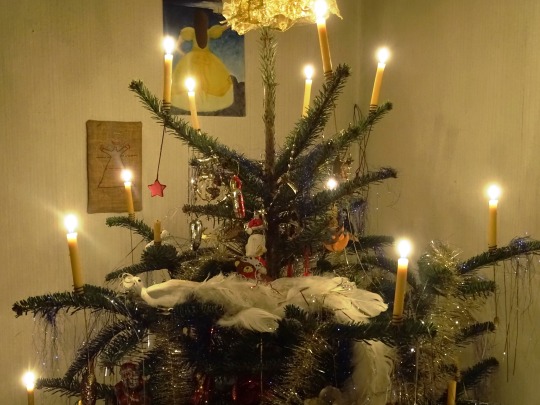
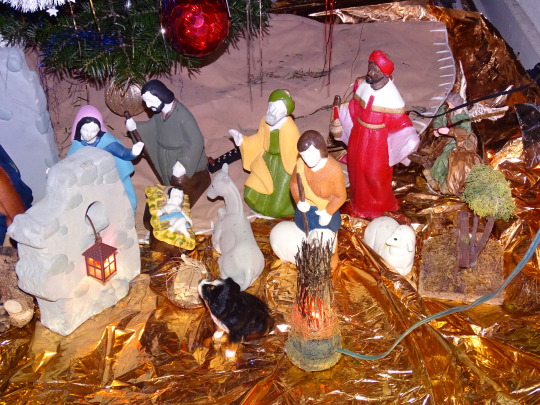

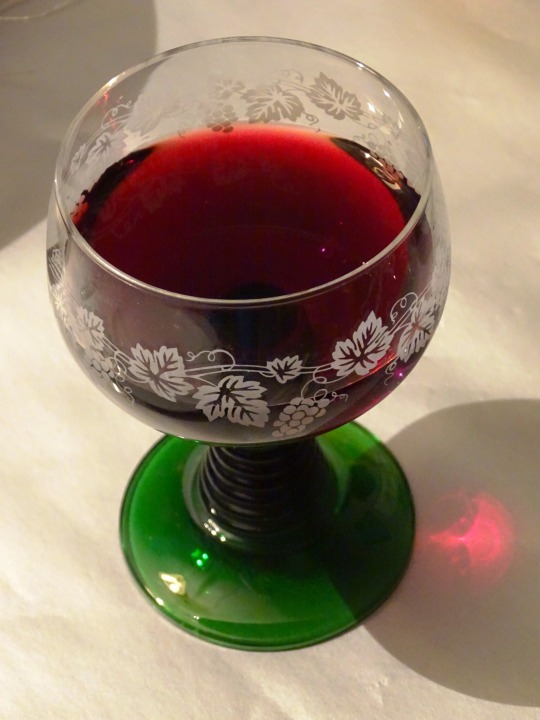

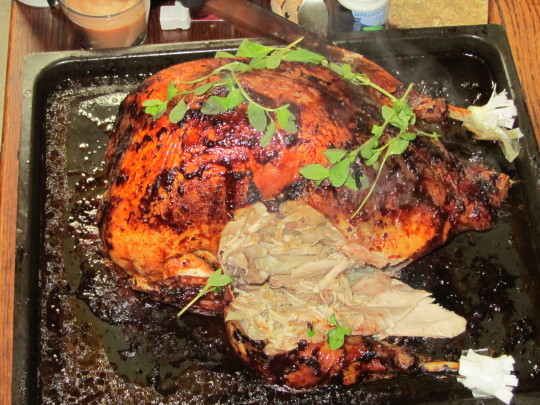
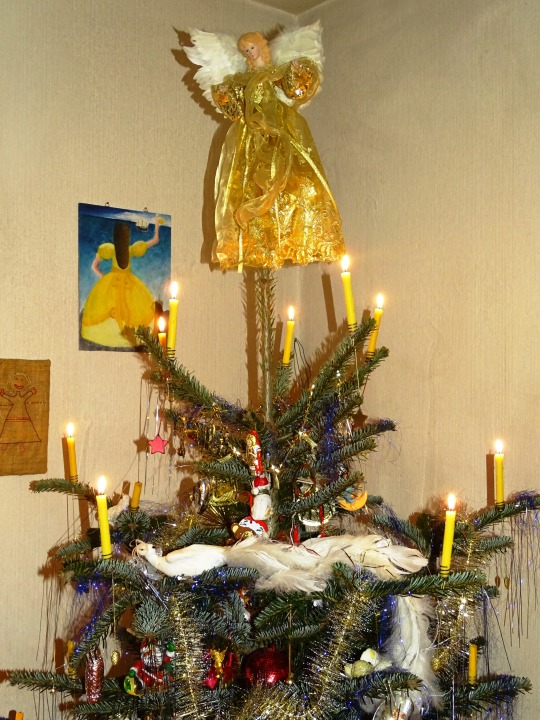
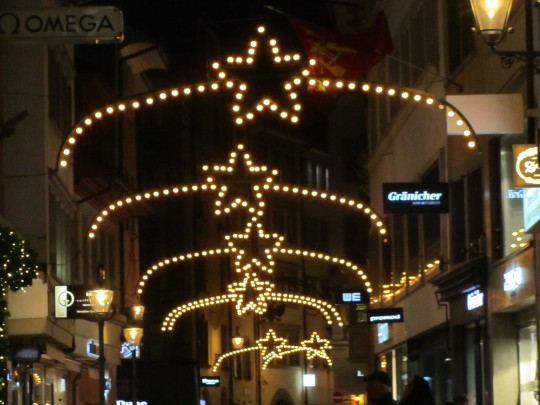
Christmas Day
Christmas Day is a Christian holiday that celebrates the birth of Jesus Christ, and it is also celebrated as a non religious cultural holiday. It is a public holiday in many countries, and is celebrated in some countries where there is not a large Christian population. It takes place after Advent and the Nativity Fast, and begins Christmastide, or the Twelve Days of Christmas. The name of the holiday is shortened from “Christ’s mass,” and throughout history the day has been known as “midwinter,” “Nativity,” “Yule,” and “Noel.”
The New Testament gospels of Luke and Matthew describe Jesus as being born in Bethlehem, in Judea. Luke’s account tells of Joseph and Mary traveling to Bethlehem from Nazareth for a census, and Jesus being born in a stable and being laid in a manger. According to this account, angels proclaimed him as the savior, and shepherds came to visit him. Matthew’s account tells the story of the magi following a star in the sky and bringing Jesus gifts.
The month and date of Jesus’ birth is unknown, but the Western Christian Church placed it as December 25 by at least 336 CE, when the first Christmas celebration was recorded, in Rome. This date later became adopted by Eastern churches at the end of the fourth century. Some Eastern churches celebrate Christmas on December 25 of the Julian calendar, which is January 7. The date of December 25 may have been chosen for a few reasons. This is the day that the Romans marked as the winter solstice, the day when the Sun would begin remaining longer in the sky. Jesus also was sometimes identified with the Sun. The Romans had other pagan festivals during the end of the year as well. December 25 also may have been chosen because it is about nine months after the date commemorating the Crucifixion of Jesus.
Christmas celebrations were not prominent in the Early Middle Ages, and the holiday was overshadowed by Epiphany at the time. Christmas started to come to prominence after 800 CE, when Charlemagne was crowned emperor on Christmas Day. During the Middle Ages it became a holiday that incorporated evergreens, the giving of gifts between legal relationships—such as between landlords and tenants, eating, dancing, singing, and card playing. By the seventeenth century in England the day was celebrated with elaborate dinners and pageants.
Puritans saw the day as being connected to drunkenness and misbehavior, and banned it in the seventeenth century. But, Anglican and Catholic churches promoted it at the time. Following the Protestant Reformation, many new denominations continued celebrating Christmas, but some radical Protestant groups did not celebrate it. In Colonial America, Pilgrims were opposed to the holiday, and it wasn’t until the mid nineteenth century that the Boston area fully embraced the holiday. But, the holiday was freely practiced in Virginia and New York during colonial times. Following the Revolution it fell out of favor in the United States to some extent, as it was seen as being an English custom.
Around the world there was a revival of Christmas celebrations in the early nineteenth century, after it took on a more family oriented, and children centered theme. A contributing factor to this was Charles Dickens’ publication of A Christmas Carol in 1843. His novel highlighted themes of compassion, goodwill, and family. Seasonal food and drink, family gatherings, dancing, games, and a festive generosity of spirit all are part of Christmas celebrations today, and were part of Dickens’ novel. Even the phrase “Merry Christmas” became popularized by the story.
In the United States, several of Washington Irving’s short stories in the 1820s helped revive Christmas, as did A Visit From St. Nicholas. This poem helped to popularize the exchanging of gifts, and helped Christmas shopping take on an economic importance. It was after this that there began to be a conflict between the spiritual and commercial aspects of Christmas as well. By the 1850s and 1860s, the holiday became more widely celebrated in the United States, and Puritan resistance began to shift to acceptance. By 1860, fourteen states had adopted Christmas as a legal holiday. On June 28, 1870, it became a federal holiday in the United States.
Celebrations of Christmas in the United States and other countries are a mix of pre-Christian, Christian, and secular influences. Gift giving today is based on the tradition of Saint Nicholas, as well as on the giving of gifts by the magi to Jesus. Giving also may have been influenced by gift giving during the ancient Roman festival Saturnalia. Closely related and often interchangeable figures such as Santa Claus, Father Christmas, Saint Nicholas, and Christkind are seen as gift givers to children—the best known of which is Santa Claus. His name is traced back to the Dutch Sinterklaas, which simply meant Saint Nicholas. Saint Nicholas was a fourth century Greek bishop who was known for his care of children, generosity, and the giving of gifts to children on his feast day. During the Reformation, many protestants changed the gift giver to the Christ child, or Christkindl, which was changed to Kris Kringle in English. The date of giving changed from Saint Nicholas Day to Christmas Eve at this time. Modern Santa Claus started in the United States, particularly in New York; he first appeared in 1810. Cartoonist Thomas Nast began drawing pictures of him each year beginning in 1863, and by the 1880s Santa took on his modern form.
Attending Christmas services is popular for religious adherents of the holiday. Sometimes services are held right at midnight, at the beginning of Christmas Day. Readings from the gospels as well as reenactments of the Nativity of Jesus may be done.
Christmas cards are another important part of Christmas, and are exchanged between family and friends in the lead up to the day. The first commercial Christmas cards were printed in 1843—the same year as the printing of Dickens’ A Christmas Carol. In 1875 the first commercial Christmas cards made their debut in the United States. Today both religious and secular artwork adorns the cards.
Music has long been a part of Christmas. The first Christmas hymns came about in fourth century Rome. By the thirteenth century, countries like France, Germany, and Italy had developed Christmas songs in their native language. Songs that became known as carols were originally communal folk songs, and were sung during celebrations such as “harvest tide” as well as Christmas, and began being sung in church. The singing of Christmas songs went into some decline during the Reformation. “Hark the Herald Angels Sing” came about in the eighteenth century, and “Silent Night” was composed in 1818. Christmas carols were revived with William Sandy’s Christmas Carols Ancient and Modern in 1833, which included some of the first appearances of “The First Noel,” “I Saw Three Ships,” “Hark the Herald Angels Sing,” and “God Rest Ye Merry, Gentlemen.” Secular Christmas songs began to come about in the late eighteenth century. “Deck the Halls” was written in 1784, and “Jingle Bells” was written in 1857. Many secular Christmas songs were produced in the 20th century, in jazz, blues, country, and rock and roll variations: Irving Berlin’s “White Christmas” was popularized by Bing Crosby; “Jingle Bell Rock” was sung by Bobby Helms; Brenda Lee did a version of “Rockin’ Around the Christmas Tree;” “Rudolph the Red-Nosed Reindeer” was recorded by Gene Autry. Elvis Presley also put out a Christmas album.
A special meal is often eaten on the day, and popular food varies from country to country. In United States, turkey with stuffing—sometimes called dressing—is often the main course, but roast beef or ham are also popular. Potatoes, squash, roasted vegetables, casseroles, and cranberry sauces are common. Popular drinks include tonics, sherries, and eggnog. Pastries, cookies, and other desserts sweeten the day, and fruits, nuts, chocolates, and cheeses are popular snacks.
Finally, Christmas decorations are an important aspect of the holiday and include things such as trees, lights, nativity scenes, garland, stockings, angels, wreaths, mistletoe, and holly. The Christmas tree tradition is believed to have started in Germany in the eighteenth century, although some believe Martin Luther began the tradition in the sixteenth century. Christmas trees were introduced to England in the early nineteenth century. In 1848 the British royal family photo showed the family with a Christmas tree, and it caused a sensation. A version of the photo was reprinted two years later in the United States. By the 1870s the putting up of trees was common in the United States. They are adorned with lights and ornaments, and can be real or artificial.
Christmas Day, also known as Christmas, is being observed today! It has always been observed annually on December 25th.
There are an innumerable amount of ways that you could celebrate Christmas:
attend a church service or read the gospel Christmas accounts
watch a Christmas film
listen to Christmas music
complete an Advent calendar or wreath
give gifts
view a Nativity play
watch a Christmas parade
visit family or friends
visit Santa Claus
read books such as How the Grinch Stole Christmas! or A Christmas Carol
light a Christingle
view Christmas decorations
go Christmas caroling
make Christmas cookies or other foods associated with the holiday
Source
#Christmas Day#ChristmasDay#25 December#it's snowing#Christmas Tree#Nativity scene#manger scene#Christmas Tree Topper#original photography#Schweiz#Switzerland#Xmas 2020#real tree and real beewax candles#homemade stuffed turkey#but not this year#Cabernet Sauvignon#Christmas Lights#Merry Christmas#Merry Xmas
2 notes
·
View notes
Link
The deep horn aboard the Binaiya rumbles as a nearby ship worker shouts, “Hurry on, we leave in 30 minutes.”
Amid the intense heat and humidity, what appears to be a sea of people squeezes through narrow gates. Above their heads, cardboard boxes of uncommon shapes crowd surf their way up to the front as the many uniformed guards stamp available arms, ensuring a steady flow. The mass moves towards the ship like a well-oiled machine of chaos. Where exactly is everyone going?
Indonesia is the world’s largest island nation, an archipelago consisting of more than 17,000 officially registered islands. While the vast majority of the 264 million people that call this country home are spread across just two of these, Java and Sumatra, many live scattered among over 6,000 other islands.
After over three centuries of Dutch colonization, and a few years of Japanese occupation, Indonesia proclaimed its independence in 1945. President Suharto’s new regime, centralized in Java, had to unify thousands of islands that had long differed in cultural customs, religions, and political structures.
In an effort to consolidate power across the archipelago, the newly formed government attempted to nationalize KPM, a Dutch-owned shipping company that dominated inter-island travel. Following a Dutch refusal to cooperate, the Indonesian government set up the Pelayaran Nasional Indonesia (Indonesian National Shipping), or PELNI for short, to regain control over their seas. With a combination of ships looted from Japan in WWII and ships rented from elsewhere, PELNI quickly emerged as the winner in this short skirmish for logistical dominion. By the end of 1957, KPM discontinued its operations in Indonesia entirely.
In an era predating affordable and convenient air-transport, PELNI became the lifeblood of local travel in Indonesia, connecting passengers and cargo to each corner of the newly united archipelago. In recent years, the company's importance in the larger, more populated islands has dwindled. But, to many of the smaller and less developed islands, primarily further east, the 26 ships still functioning are absolutely vital. They stop at places where air travel has remained an impracticality and crops are less easily grown.
Binaiya is a fairly standard model in the fleet. It officially sleeps 960 passengers, though a number closer to 1,500 is not uncommon. On the upper decks, there are a few private cabins that sleep two or four. However, the vast majority of passengers sleep in rooms of up to 200 in the massive dormitory decks.
Though routes of these boats are infamously prone to change, Binaiya regularly travels between five major islands: Bali, Sumbawa, Flores, Sulawesi, and Borneo. Dormitory tickets for the 30-hour Bali-to-Flores leg cost $15 and include six meals.
Soon after leaving the port, Binaiya takes on a life of its own. Many of the kids on board rush to the upper deck, where strong winds drown out their excited chatter. In the shaded regions, large groups circle around decks of cards. Cigarettes are passed around and, in between the small meals, copious amounts of Indomie (Indonesia’s most popular Instant Noodle) are devoured.
Every leg of a PELNI journey has its own clientele. On boats leaving from Bali, migrant workers looking to capitalize off of the tourism craze might be the most common. For young Indonesians from islands such as Flores, Sulawesi, and Sumbawa, the booming tourism industry in Bali offers stable job opportunities in hospitality and transport.
William, a local passenger, is from the Manggarai province in Flores. The population of his home town, Golocala, is roughly 1,000. Many of the people here, his family included, spend their days farming the region's main crops: coffee and rice. Curious about the opportunities offered on some of the other islands, William boarded his first PELNI six years ago. A little less than two days later, he landed in his new home, Bali. After some time wandering around the island, William found work as a manager for a pair of small villas in Uluwatu, a popular surf town for tourists.
Generally, William returns home via PELNI once or twice a year. "Almost all of the people I know are using it because it is very cheap," he says. On this particular trip, he is off to see his newborn baby for the first time. His wife, who also moved to Bali to find work in the tourism industry, had moved home just a month earlier to prepare for the birth of their child. “In Bali, having our baby in a hospital will be maybe seven or eight times more expensive than in my province,” William says.
Eventually, William and his wife plan to move back home to set up a small shop with the money they have saved in Bali. Growing up with nine siblings in a village of fewer than 1,000 people, there is a sense of community ingrained in him. “When I first left,” William says, “all I wanted was to experience different kinds of life. Now, I mostly just want to be with my family again, to feel at home.” His mind momentarily drifts before rejoining the conversation once again. “In my family, only me and one of my sisters left Golocala. But, on this boat, there are many people from Manggarai, just like us, who can’t wait to be living at home again.” Until then, the cheap price of PELNI allows William, and many others, to travel home a few times a year, for a fraction of the cost of an airline ticket.
After nearly 24 hours floating across the calm of the Bali Sea, we dock in Bima, the largest city in Sumbawa. The docking process is always a spectacle.
From the moment the gates open, food vendors rush aboard, racing to their chosen spot on the deck. All too aware of the less-than-ideal meals served on the boat, locals come laden with local delights like nasi campur and ayam goreng, as well as popular sweets such as dadar and wajik.
On the ground level, hundreds of family members line the docks eagerly awaiting the return of their loved ones as other families begin their goodbyes. Beside the boat, trucks full of corn, onion, and garlic, the main exports of Bima, load tons of products abroad. These shipments will be gratefully received by various islands less able to grow their own.
At this particular port, far more passengers get on than those who leave. An already over-capacity ship sees its hallways nearly overflow. After a couple of hours, the deep horn of Binaiya rumbles once again and the many vendors scatter back ashore. Before long, Binaiya is on the move, with Flores a mere six hours away.
Once commanding a fleet of over 50 vessels, PELNI is no longer as popular as it once was. As the nation experiences a continuous rise in affordable air travel, shipping routes available to the public will decrease. Unfortunately, for an archipelago so large, modernization occurs at very different speeds. So, while some larger islands are losing the need for these boats, many smaller islands have come to rely on them more than ever.
On the Eastern end of the archipelago, where lands are often less fertile, mass shipments of rice, onions, corn, and other basic foods are critical. Each time a route closes, these islands face less-regular shipments and added obstacles for leaving and returning home. Thankfully, a restructuring of the ticketing system and improvements to customer experience has led to an increase in low-budget local passengers, like William, over the last five years. After nearly two decades of declining popularity, PELNI seems to be turning a corner.
For millions of Indonesians, this means that dreams of better job opportunities and new homes are still on the horizon. For William, his goal is to ultimately return home. He will once again take a rather long boat ride.
28 notes
·
View notes
Text
Pembrokeshire, county of castles, coves and film star sands.
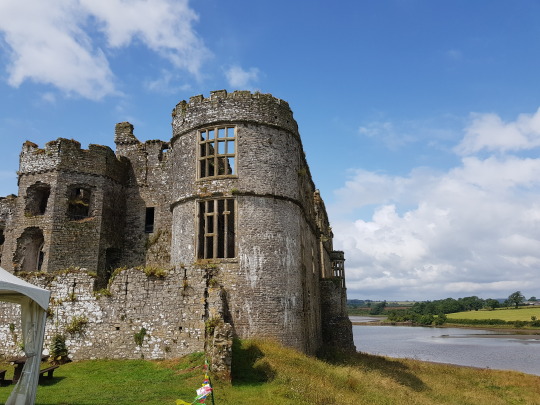
The eye was piercing. The gaze was imperious. The message an unspoken “Do you know who’s in control around here?” Eventually, of course, the human in boots, inching forward as quietly as he could along the Pembrokeshire Coast Path, prevailed over the haughty feathered hunter perched on a fence post.
I was no more than 15 feet away, with the summit of nearby Carn Llidi as a backdrop, when the sparrowhawk very reluctantly gave way. It lifted off and, after a few grudging wing beats, alighted again about six posts along.
In the space of ten minutes, as I moved slowly forward, it repeated this procedure: lift off, lazy flutter of wings and perch again, about fives times, before cutting back in a wide arc across the field to roughly where I first met it.
The guidebooks tell you to look down from the cliffs for seals, porpoises, dolphins and to the windy space between land and sea for choughs, those comical blackbird-size birds with red legs. But not a word about this top predator, which had clearly dined so well on the local singbirds that it scarcely needed to move. (The birds sang on, despite the predations.)
Approach this national trail as you might a long, detailed menu in a restaurant, one with a wide choice of starters, many of them a meal in itself. There are also some main courses, specialities of this county, and you will want to sample one or two of them. However you would need a giant’s appetite to consume the whole 186-miles, still less the entire 870 miles Wales Coast Path, of which this is only a section.
Let’s start with those appetizers. (The sparrow hawk would be in the “today’s specials” section.) I stayed at the county’s western end, on its final thrust towards Ireland. As the chough flies, Waterford is closer than Cardiff.
Hearabouts any three to five mile stretch contains many permutations. The trail twists, it lurches, it plunges, it turns severely back on itself then climbs steeply down into and up out of tiny coves. Little tumbling streams cross your path. Banks dense with foxgloves enclose your way. A flower strewn meadow ends in a sudden sheer drop down to waves boiling over jagged rocks. The view constantly changes. Nothing stays the same on this path for more than a few minutes.
I did an idle measurement on Google Maps afterwards. Made into a straight line the Pembrokeshire Path would stretch here roughly from London, 198 miles away. In 2010, duly impressed, National Geographic Magazine judged this the second best coastal destination in the world, just behind the Avalon Peninsula in Newfoundland, Canada.
Every three or four miles, over much of the western end at least, there is a convenient pause, in the shape of an attractive little harbour, and there’s a fair chance it is served by the coastal bus.
This part of the coast was bristling with unexpected, at least to me, industrial history. We think of the Welsh valleys studded with smokestacks and pit heads, but there is the evidence of long and serious industry in this quiet backwater. The clues that somewhere, such as Abereiddi, was once very busy is in the eroded remains of labourers’ cottages. In other places those that stood up long enough after the decline are now holiday cottages.
We dropped down into Porthgain, an industrial powerhouse in its day. The roads of England were paved with crushed dolerite processed here. Now gentrification is complete. The main industrial building is now the Shed Fish and Chip Bistro. On our visit no fewer than ten Norwegian-registered vintage MG sportscars were neatly parked on the quayside.
The drivers and passengers were in the Shed, where they may well have been enjoying the exquisite if expensive fresh crab sandwiches, sold at prices Chiswick visitors would recognize. We ordered the same at the Sloop Inn opposite. We were perfectly positioned, some time later, to see the MGs set off in orderly convoy on the road to Fishguard.
The coast continues like this for miles, with a spot of strenuous striding, frequent heart-lifting views, tantalising glimpses of islands big and small just off the coast. Here and there an encounter with a profound religious past, in the ruined chapel and well of St David’s mother St Non, for example.
There are other, bigger harbours. In Solva the man in the car park handed out leaflets promoting all the little art craft shops, restaurants and guest houses. The Dutch and German cars underline the county’s appeal to a discerning international market – the drivers were not there for the weather.
And so to those landscape “main courses” I mentioned. On the path from the lifeboat station at St Justinians, heading north, I am suddenly above a wide, flat, sandy beach where somebody had expertly drawn a vast jellyfish, so big it could only be seen to proper effect from 200 yards up, on the footpath.
Pembrokeshire’s beaches are now an international hot property. Hollywood could have chosen some enchanted strand on Bali or Hawaii as the location where Kristen Stewart thunders through the surf with 80 muscular extras on horseback in the 2012 movie ”Snow White and the Huntsman”. Instead the studios chose the wide, flat, golden film-star sands, perfectly smoothed by the outgoing tide, of Marloes Sands, on southern Pembrokeshire, even if they did computer-generate an extravagant outburst of fairy-tale towers on the conveniently flat-topped Gateholm Island, which stands just yards off the headland.
Marloes first broke into the movies in 1967 when The Lion in Winter was filmed here. Whitesands was used in the BBC4 Richard II.
In 2010 Hollywood came to another Pembrokeshire beach, Freshwater West. Ridley Scott had filmed Robin Hood there, with Russell Crowe. The filmmakers built higgledy-piggledy Shell Cottage there for Harry Potter and the Deathly Hallows. The beach is clearly visible in the film. You will find no trace that the scrupulously tidy film makers were ever there. It’s the same at Marloes, left just as they found it.
You could easily construct a week or ten day holday around this sublime coastland, mixing up walks with boat trips to Skomer or Ramsey, dining out in the many harbour pubs on fresh local fish. The coast path has been conveniently cut up into 200 bite-size local walks, some of them circular.
One took us a few miles inland to St Davids, which is Britain’s smallest city, by virtue of the cathedral. We arrived early to benefit from its remoteness. Most day trippers, coming from afar, don’t get there until well on in the morning. We came across the intimate little cathedral, nestling in a green valley, well before the throng.
In the nave we had plently of room for some entry-level surveying, measuring the startling incline on the spirit level app on my daughter’s smartphone. It is almost two degrees.
St David’s has an understated nobility, because of its size and unusual position. On a scale of conspicuous cathedrals, Lincoln would be a 10. St David’s would be a 1. It was a steep climb up to the city, in reality a pleasant little town, where we gave in to the Italian charms of the Bench cafe for coffee and ice cream.
Until the early 1800s Pembrokeshire would have been as remote by land as some European cities were for a traveler starting out from London. Railways opened the county up, and oil at Milford Haven and the Irish boat traffic through Fishguard Harbour ensured the rail links survived even in the bleak post-Beeching era.
The trains helped build Tenby into as gracious a Victorian resort as Whitby or Ilfracombe. Novelist George Eliot was inspired enough by her visit to this perfect little resort in 1856 to take up writing. It has been a destination of rare distinction ever since.
A cordon of high, narrow Georgian and Victorian town houses in delicate pastel colours still wraps around Tenby’s sea front. To dodge the wind you either head to the sandy beach on the town’s north flank, or, if it’s blowing from the other direction, seek out the little harbour to the south.
Praise, then, for frequent services direct from Manchester deep into Pembrokeshire, connecting with services from London and the west and south.
It’s still the case, of course, that most visitors drive here. They will find the car necessary for visiting the centre of the county where the excellent bus service doesn’t reach.
Pembroke, is technically on the coast. The tide probes almost under the walls of the castle where Henry Tudor, who became Henry VII, was born in 1457, (It was restored to its formidable Norman pomp after a crumbly, ivy-covered interlude in the 1900s.) But it feels like an inland town.
The castle, proud and imposing above this ancient town, is just one the county’s rich crop of citadels, The list includes Manorbier, Cilgerran, Haverfordwest, Lamphey, Llawhaden, and Picton castles. There are over 50 all told, if you include forts and the reconstructed 600 BC Iron Age citadel Castell Henllys. Leading the list is Carew Castle. It overlooks a serene millpond, with a 11th century Celtic Cross and Wales’s only restored Tidal Mill. Narberth is another appealing little castle town. If you buy the Welshcakes in Waitrose, they come from here.
6 notes
·
View notes
Text
Ethics in the Workplace
New Post has been published on https://wr1tepress.com/ethics-in-the-workplace/
Ethics in the Workplace
While the world pays respectful tribute to Rembrandt Van Ryn the artist, it has been compelled to wait until comparatively recent years for some small measure of reliable information concerning Rembrandt Van Ryn the man. Rembrandt Van Ryn was born in the pleasant city of Leyden, but it is not easy to name the precise year. Somewhere between 1604 and 1607 he started his troubled journey through life, and of his childhood the records are scanty. Doubtless, his youthful imagination was stirred by the sights of the city, the barges moving slowly along the canals, the windmills that were never at rest, the changing chiaroscuro of the flooded, dyke-seamed land. Perhaps he saw these things with the large eye of the artist, for he could not have turned to any point of the compass without finding a picture lying ready for treatment.
His family soon knew that he had the makings of an artist and, in 1620, when he could hardly have been more than sixteen, and may have been considerably less, he left Leyden University for the studio of a second-rate painter called Jan van Swanenburch. We have no authentic record of his progress in the studio, but it must have been rapid. He must have made friends, painted pictures, and attracted attention. At the end of three years he went to Lastmans studio in Amsterdam, returning thence to Leyden, where he took Gerard Dou as a pupil. A several years later, it is not easy to settle these dates on a satisfactory basis, he went to Amsterdam, and established himself there, because the Dutch capital was very wealthy and held many patrons of the arts, in spite of the seemingly endless war that Holland was waging with Spain.
His art remained true and sincere, he declined to make the smallest concession to what silly sitters called their taste, but he did not really know what to do with the money and commissions that flowed in upon him so freely. The best use he made of changing circumstances was to become engaged to Saskia van Uylenborch, the cousin of his great friend Hendrick van Uylenborch, the art dealer of Amsterdam. Saskia, who was destined to live for centuries, through the genius of her husband, seems to have been born in 1612, and to have become engaged to Rembrandt Van Ryn when she was twenty. The engagement followed very closely upon the patronage of Rembrandt Van Ryn by Prince Frederic Henry, the Stadtholder, who instructed the artist to paint three pictures.
Saskia is enshrined in many pictures.
She is seen first as a young girl, then as a woman.
As a bride, in the picture now at Dresden, she sits upon her husbands knee, while he raises a big glass with his outstretched arm.
Her expression here is rather shy, as if she deprecated the situation and realised that it might be misconstrued.
This picture gave offence to Rembrandt Van Ryns critics, but some portraits of Saskia remained to be painted.
She would seem to have aged rapidly, for after marriage her days were not long in the land.
She was only thirty when she died, and looked much older.
In 1638 we find Rembrandt Van Ryn taking an action against one Albert van Loo, who had dared to call Saskia extravagant. It was, of course, still more extravagant of Rembrandt Van Ryn to waste his money on lawyers on account of a case he could not hope to win, but this thought does not seem to have troubled him. He did not reflect that it would set the gossips talking more cruelly than ever. Still full of enthusiasm for life and art, he was equally full of affection for Saskia, whose hope of raising children seemed doomed to disappointment, for in addition to losing the little Rombertus, two daughters, each named Cornelia, had died soon after birth. In 1640 Rembrandt Van Ryns mother died. Her picture remains on record with that of her husband, painted ten years before, and even the biographers of the artist do not suggest that Rembrandt Van Ryn was anything but a good son. A year later the well-beloved Saskia gave birth to the one child who survived the early years, the boy Titus. Then her health failed, and in 1642 she died, after eight years of married life that would seem to have been happy. In this year Rembrandt Van Ryn painted the famous “Night Watch,” a picture representing the company of Francis Banning Cocq, and incidentally a day scene in spite of its popular name. The work succeeded in arousing a storm of indignation, for every sitter wanted to have equal prominence in the canvas.
It may be said that after Saskias death, and the exhibition of this fine work, Rembrandt Van Ryns pleasant years came to an end. He was then somewhere between thirty-six and thirty-eight years old, he had made his mark, and enjoyed a very large measure of recognition, but henceforward, his career was destined to be a very troubled one, full of disappointment, pain, and care. Perhaps it would have been no bad thing for him if he could have gone with Saskia into the outer darkness. The world would have been poorer, but the man himself would have been spared many years that may be even the devoted labours of his studio could not redeem.
Between 1642, when Saskia died, and 1649, it is not easy to follow the progress of his life; we can only state with certainty that his difficulties increased almost as quickly as his work ripened. His connection with Hendrickje Stoffels would seem to have started about 1649, and this woman with whom he lived until her death some thirteen years later, has been abused by many biographers because she was the painters mistress.
He has left to the world some 500 or 600 pictures that are admitted to be genuine, together with the etchings and drawings to which reference has been made. He is to be seen in many galleries in the Old World and the New, for he painted his own portrait more than a score of times. So Rembrandt Van Ryn has been raised in our days to the pinnacle of fame which is his by right; the festival of his tercentenary was acknowledged by the whole civilised world as the natural utterance of joy and pride of our small country in being able to count among its children the great Rembrandt Van Ryn.
0 notes
Photo
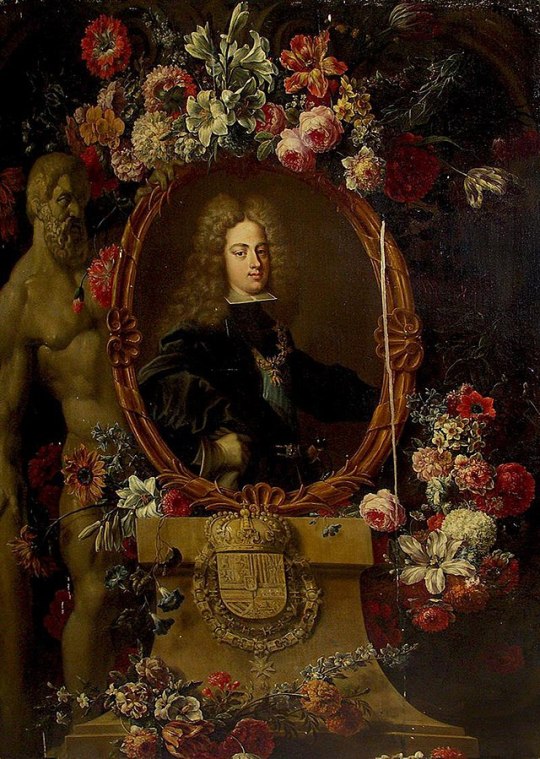
Gaspar Peeter Verbruggen the Younger - Portrait of Philip V in a Flowered Frame - 1704
Philip V (Spanish: Felipe V, French: Philippe, Italian: Filippo; 19 December 1683 – 9 July 1746) was King of Spain from 1 November 1700 to his abdication in favour of his son Louis on 14 January 1724, and from his reaccession of the throne upon his son's death, 6 September 1724 to his own death on 9 July 1746.
Before his reign, Philip occupied an exalted place in the royal family of France as a grandson of King Louis XIV. His father, Louis, Grand Dauphin, had the strongest genealogical claim to the throne of Spain when it became vacant in 1700. However, since neither the Grand Dauphin nor Philip's older brother, Louis, Duke of Burgundy, could be displaced from their place in the succession to the French throne, the Grand Dauphin's maternal uncle (Philip's granduncle) King Charles II of Spain named Philip as his heir in his will. It was well known that the union of France and Spain under one monarch would upset the balance of power in Europe, such that other European powers would take steps to prevent it. Indeed, Philip's accession in Spain provoked the 13-year War of the Spanish Succession, which continued until the Treaty of Utrecht forbade any future possibility of unifying the French and Spanish crowns while confirming his accession to the throne of Spain.
Philip was the first member of the French House of Bourbon to rule as King of Spain. The sum of his two reigns, 45 years and 21 days, is the longest in modern Spanish history.
The War of the Spanish Succession (1701–1714) was a European conflict of the early 18th century, triggered by the death of the childless Charles II of Spain in November 1700. His closest heirs were members of the Austrian Habsburg and French Bourbon families; acquisition of an undivided Spanish Empire by either threatened the European balance of power and thus involved the other leading powers. Related conflicts include Rákóczi's War of Independence in Hungary, the Camisard revolt in Southern France, Queen Anne's War in North America, and minor struggles in Colonial India. The 1700-1721 Great Northern War is viewed as connected but separate.
Charles bequeathed an undivided Monarchy of Spain to Louis XIV's grandson Philip, who was proclaimed King of Spain on 16 November 1700. Disputes over territorial and commercial rights led to war in 1701 between the Bourbons of France and Spain and the Grand Alliance, whose candidate was Archduke Charles, younger son of Leopold I, Holy Roman Emperor.
By the end of 1706, the French had been forced back to their borders but the Allies could not break their lines, while lack of popular support in Spain meant they could not hold territory outside Catalonia. When his brother Emperor Joseph I died in 1711, Charles succeeded as Emperor; since the war was fought to prevent union of Spain with either Austria or France, the new British government sought to end the conflict. The Allies, unable to continue the conflict without British support, agreed to the 1713 Treaty of Utrecht, then the 1714 treaties of Rastatt and Baden.
Philip was recognised as king of Spain, but renounced his right to the French throne, for himself and his descendants; Spain retained the bulk of its possessions outside Europe, but lost territories in Italy and the Netherlands to Austria and Savoy. The Dutch regained their Barrier, France acknowledged the Protestant succession in Britain and ended support for the Jacobites. Longer term, the war marked Britain's rise as the leading European maritime and commercial power, and the decline of the Dutch Republic as a first-rank power. It also led to the creation of a centralised Spanish state, the weakening of Habsburg control over the Holy Roman Empire, and the rise of Prussia, Bavaria and Saxony.
Gaspar Peeter Verbruggen or Gasparo Pedro Verbruggen (baptized on 11 April 1664 in Antwerp – buried on 14 March 1730 in Antwerp) was a Flemish still life painter who is principally known for his decorative still lifes with flowers and fruit. He collaborated with figure artists on compositions which combined figures with a still life element. He was active in Antwerp and The Hague.
21 notes
·
View notes
Text
ARCHITECTURAL LED PRODUCTS
LEDs are next generation lighting technology that are more flexible and efficient in terms of colors, form factor, and power consumption as compared to conventional incandescent light products. LEDs are not sensitive to cold which makes them ideal for outdoor lighting. LEDs obtain the colors from semiconductor chips, thereby eliminating the need for using color filters and making LEDs more efficient than traditional lights. LEDs directional lights can easily and accurately be directed on facades, thus preventing stray light. In media facades thousands of LEDs lights are linked together and controlled individually. By using LEDs, images and messages come alive and make corporate building and malls real crowd pullers.
· For instance, an average LED lamp consumes 50% less power than fluorescent lamp and 80% less than incandescent lamp
Nowadays, large number of organizations prefer architectural LED Products, as they have more lifespan than incandescent lights. With a longer lifespan, LEDs help reduce labor cost of replacing lights in commercial situations and achieve lower maintenance lighting system. Some of the benefits of architectural LED products are that they provide more brightness than traditional lights, they do not emit infrared radiation or ultraviolet radiation, which result in lower cost and increased reliability of LEDs.
Architectural LED Products Market: Taxonomy
PMR’s research study on the global architectural LED products market offers a detailed market taxonomy, wherein the key segments have been discussed in detail. The segmentation of the architectural LED products market has been offered on the basis of product type, application, end-user and region. Every segment has been analyzed in detail and data pertaining to the growth of each segment has been included in the study.
Product Type
Application
End-user
Region
Solar
Cove Lighting
Residential
North America
Conventional
o Strip & Linear
o Lamps
Wall Washers
Commercial
o Retail
o IT & Telecommunication
o BFSI
o Media & Entertainment
o Healthcare
o Others
Latin America
In-Ground
Western Europe
Backlight
Eastern Europe
Others
Asia Pacific Excluding Japan
Japan
Middle East and Africa
TOP COMPANIES:
Philips Electronics India Ltd
Let’s face it. You have known this brand since you were a child. Philips is a Dutch brand, but it considers India to be its biggest market as far as LED lights are concerned. It is one of the most trusted and relied upon brand for LED lights among consumers. The firm boasts of cutting-edge technology and a wide range of LED lighting solutions to the Indian customer. It has a wide portfolio of LED lights, that is, Philips has an LED for people from every walk of life. Globally too, the firm is a leader in LED lighting. And it has made sure that it brings all that global experience and expertise for its products in India.
Osram India Pvt Ltd
People swear by German engineering. The Germans are considered to be the best brains in making machines of all kinds. So, what happens when a German company decides to open a manufacturing plant in India? Quite simply, you get robust German engineering- which means fuss-free LED lighting. Osram India, a complete subsidiary of Osram GmbH, offers its customers a wide range of LED lighting solutions. With manufacturing plants in Sonepat and Kundli, the company has managed to make LED lights for India, in India. From Indoor LED modules to exterior modules; from lamps to general lighting, Osram India has a solution for all your LED lighting needs.
Havells India Ltd
Here’s a fun fact, Havells has 14 different manufacturing locations in India alone. You might know the company from the famous cable advertisement that says that Havells’ cables never catch fire. And that is really a testament to the company’s quality control. Havells is a new entrant in LED lighting sphere, after it started manufacturing LED lights in 2010. And in that short span of time, it has established itself as one of the best LED lighting companies in India. Havells’ LED lighting solutions include spot lights, lamps, ceiling lights to name a few.
Bajaj
If you’ve ever driven an automobile made by Bajaj, you know how rugged and long lasting its products are. Fortunately for all of us, when the firm decided to make LED lights, it brought along the same manufacturing ethics with itself to provide the best possible product to its consumers. The company has over 7 decades of experience in the lighting industry and it is easy to spot that in its LED lights. Just like its two and three wheelers, Bajaj’s LED lights are long-lasting and some of the longest lasting LED lights in India. Bajaj is definitely one of the best LED lighting companies in India.
Wipro
From selling vegetable oil to computer solutions to LED lighting, Wipro has really seen it all in its ascension to being one of India’s LED lighting companies. Wipro provides LED lighting solutions for residential spaces, office spaces, and industries. The company is one of the fastest growing lighting firms in India and for good reasons. With its green yet efficient LED lighting solutions, the company boasts of a massive lighting portfolio for all kinds of use. Also notable is Wipro’s offering of mixed LED lights that can provide colour output from any conceivable colour palate.
Eveready
The company completed a century in the dry cell battery market in 2005. That goes on to the show the reliability and quality of its products. And when Eveready decided to step into the LED lighting market, it was welcomed warmly by its faithful customer base. With LED lighting solutions as wide as the Amazon River, the company takes care of both urban and rural needs efficiently.
SYSKA LED
SYSKA is a testament to the fact that you don’t have to be a century old company to sell things. The firm is only about two decades old, and in that short span, it has managed to grab a sizeable market share of LED lighting. You might know the company from witty ads featuring Indian actor Irfan Khan. But even without them, the company stands as one of the best LED lighting companies in India. With smart innovation and products that are priced fairly, SYSKA has managed to grab millions of eyeballs for all good reasons.
Moser Baer
After being a world leader in manufacturing CDs and DVDs, Moser Baer decided to step into the LED lighting sphere. The company, that is reportedly worth Rs 19,000 crores also covenanted to save 50 MW of energy in two years. To fulfill its promise, the company presented a wide range of efficient LEDs that did the job without being too heavy on the customer’s electricity bills. We all know that LED lighting is perhaps the most efficient way of lighting today, and it is wonderful to see major companies like Moser Baer in spreading awareness about it.
Surya
Surya is one of the biggest LED manufacturers in India with 50 different products in the Indian market right now. However, being a forward facing company, Surya has announced that it will launch 50 more products in the coming years. Surya LED lamps provide the best output along with a long life. More than that, they save up to 90 per cent of energy. The company’s manufacturing plant in NOIDA is one of the most sophisticated in the country.
Market Overview
An LED light bulb or lamp is an electric light that is primarily used in light fixtures by using one or more light-emitting diodes. LED lamps are energy-efficient, have a longer lifespan, and use only a fraction of energy as compared to equivalent incandescent lamps. LED lights emit around 90% lesser heat than incandescent lamps. In the recent past, the prices of architectural LED products have decreased significantly, which in turn, has increased its adoption for various applications. In architectural lighting, both technology and art are used to attain aesthetically pleasant lighting and energy-efficient lighting. The architectural lighting is done for commercial as well as residential projects. According to Coherent Market Insights’ analysis, the average selling price of LED products declined by 20% in 2014.
The global architectural LED products market is estimated to account for US$ 8,067.3 Mn in terms of value by the end of 2019
Market Dynamics- Drivers
1. Growing consumer inclination towards luxurious lifestyle is expected to drive growth of the global architectural LED products market during the forecast period
Increasing consumer inclination towards luxurious lifestyle has boosted the demand for LED lighting products significantly worldwide. This demand has been observed in commercial as well as residential sectors. Moreover, the government offices and monuments are increasingly adopting architectural LEDs luminaries and lamps as part of smart city initiatives. Thus, these factors are expected to support growth of the global architectural LED products market over the forecast period. For instance, in 2013, the Royal Castle in Warsaw, Poland, installed Philips’ LED solution eW Graze linear lighting solution on the façade of the royal castle. The motive behind installation of architectural LED lights is to display the color of the facade as realistically as possible. Furthermore, in 2014, the Turkish government awarded a contract to Philips to install architectural LED products across 21 sites in Ankara city.
2. Stringent government regulations regarding deployment of LED lamps is expected to propel the global architectural LED products market over the forecast period
Government regulatory policies concerning construction of artistic buildings across various regions have accelerated the deployment of efficient lighting systems by construction companies. Moreover, government organizations across the globe are emphasizing on the implementation of minimum standards for lighting products efficiency and ban adoption of incandescent lighting products, in order to enhance the efficiency and cut-down CO2 emission. For instance, the Government of China has banned the use of 1000W and 60W incandescent bulbs across the country. Moreover, the European Union (EU) has banned the usage of all types of conventional incandescent lamps in the region. Hence, these factors are expected to boost the market growth in the near future.
Asia Pacific region dominated the global architectural LED products market in 2019, accounting for 52.3% share in terms of value, followed by Europe, and North America respectively.
Market Dynamics- Restraints
1. High initial cost of installation is expected to hamper the global architectural LED products market growth over the forecast period
Compared to commercial sector, adoption of LED lighting products in residential sector is relatively low. This is owing to high initial cost of installation. Residential users are still preferring low-cost lighting technology products such as fluorescent lighting fixtures, particularly in emerging economies. This, in turn, is expected to hinder the demand for LED lighting products and thereby restrict the market growth over the forecast period. Currently, cost of 60W equivalent LED bulb is 9X that of 60W florescent bulb.
2. Consumer inclination towards other lighting technology products is expected to restrain growth of the global architectural LED products market during the forecast period
In the current scenario, fluorescent technology products account for the larger share of the overall lighting market as compared to architectural LED lighting fixtures. According to Coherent Market Insights’ analysis, in 2012, fluorescent lamps accounted for a 12% share of the overall lighting market, while market share of LED lighting was around 10%. Therefore, these factors are expected to hamper the market growth over the forecast period.
Market Opportunities
1. Tie-ups and partnerships with construction companies and home builders are expected to pose lucrative growth opportunities
Growing construction business across the globe has presented an excellent opportunity for architectural LED products provider to partner with construction companies and home builders. Installation of energy- and cost-effective lighting systems in the commercial sector presents huge market opportunity for providers of architectural LED products. According to Coherent Market Insights’ analysis, the global construction market is projected to grow at an annual average of 4.1% during the forecast period (2015–2021). Furthermore, key companies in the market have significant opportunity to sign agreement construction companies, in order to gain competitive advantage in the market. For instance, in September 2012, PhotonStar LED Group plc signed a one year LED light fixtures supply agreement with a leading U.K. home builder. The installation of LED light fixtures in new constructions helped the home builder meet carbon-emission target in a cost-effective manner.
2. Tie-ups with e-commerce companies are expected to offer significant business opportunity
High growth e-commerce business in emerging economies such as Brazil, India, and China has offered lucrative growth opportunity for architectural LED products manufacturers and providers. Key manufacturers can tie-up with online retailers such as eBay and Amazon Inc., in order to endorse architectural LED lighting products and solutions among consumers.
Source: Coherent Market Insights
Global architectural LED market, by application type segment, wall washing type sub-segment was accounted for 39.8% market share in 2019 and is expected to grow at a CAGR of 18.5% between 2019 and 2027.
Source: Coherent Market Insights
Market Trends
1. Growing mergers and acquisitions among key players are expected to be a major trend
Key companies in the market are focused on strategic activities such as mergers and acquisitions, in order to enhance their presence in the global market and gain competitive edge. For instance, in May 2015, Leviton Manufacturing Co., Inc. acquired Intense Lighting LLC and expanded its product portfolio with the addition of the latter’s LED lighting solutions for the residential, retail, commercial and hospitality sectors. Moreover, in September 2013, Magic Lite Ltd. acquired National Specialty Lighting—an architectural and specialty lighting company—in order to enhance its technological capabilities to manufacture advance LED lightings and presence in the U.S. architectural LED lighting market.
2. Strategic partnerships and collaborations with e-commerce platform providers is another major trend in the market
Growing adoption of LED lights in various industries have compelled architectural LED products providers and e-commerce companies to form strategic alliance, order to expand their consumer base and gain competitive edge in the market. For instance, in July 2014, Phillips Lighting Limited entered into a strategic alliance with Amazon.com, Inc. in order to enhance its presence in the market.
Regulations
North America
In December 2007, President George W. Bush signed the Energy Independence and Security Act of 2007 (EISA 2007) with the purpose to establish new efficiency standards for products, public buildings, and vehicles and to enhance production of clean renewable fuels. Subtitle B, Section 321 of the EISA 2007 legislation established a phase-out timetable for 40, 60, 75, and 100 watt incandescent lamps as well as standards and a phase-in schedule for appropriate replacement lamps.
Competitive Section
Key companies operating in the global architectural LED products market are Epistar Corporation, GE Lighting LLC, Galaxia, Cree Inc., Cooper Industries PLC, Signify N.V., Philips Lumiled Lighting Company LLC, Verbatim Ltd., Osram Licht AG, Toshiba Lighting & Technology Corporation, and Samsung Electronics.
Key Developments
1. Major market players are focused on mergers and acquisitions, in order to gain competitive edge in the market. For instance, in November 2018, American Industrial Partners, a U.S.-based private equity firm, acquired GE Lighting LLC’s solid-state lighting (SSL) business unit.
2. Key players in the market are involved in product launch, in order to enhance their product portfolio. For instance, in July 2018, Cree Inc., a U.S.-based provider of LED lighting, introduced new High Efficiency (HE) version of XLamp XP-G2 LED.
1 note
·
View note
Text
#10yrsago Julian Comstock: Robert Charles Wilson's masterful novel of a post-collapse feudal America: "If Jules Verne had read Karl Marx, then sat down to write The Decline and Fall of the Roman Empire"

Robert Charles Wilson's Julian Comstock: A Story of the 22nd Century was pressed into my hands by my editor, Patrick Nielsen Hayden, seconds after I told him that I absolutely, positively could not take any more books with me because I was totally snowed under, a year behind on my reading. "Read this one," he said. "It's worth it."
It was worth it.
The early jacket copy for Julian Comstock reads, in part, "If Jules Verne had read Karl Marx, then sat down to write The Decline and Fall of the Roman Empire, he still wouldn't have matched the invention and exuberance of Robert Charles Wilson's Julian Comstock." Damn right.
Julian is the story of a world sunk into feudal barbarism, 150 years after Peak Oil, plagues, economic collapse and war left the planet in tatters. Now, America (grown to encompass most of Canada, save for deeply entrenched Dutch and "mitteleuropean" forces in the now-verdant Labrador) is ruled over by a mad hereditary president, whose power is buoyed up by the Dominion, a religious authority that represents the true power in a nation where the new First Amendment guarantees the right to worship at any sanctioned church of your choosing.
The president's nephew, Julian Comstock, has been squirreled away to "Athabaska" to escape the attention of his uncle, who has already assassinated Julian's father, fearing a coup. In the bucolic Alberta farms, Comstock befriends Adam Hazzard, the charming, naive and eloquent narrator of the story. Hazzard is the son of a bondsman who is attached to the feudal territory of the local lord, and is an outcast due to his adherence to a disfavored sect of snake-handlers.
The president is determined to eliminate the threat that Julian poses to his throne, so he issues a general order of conscription for young men to go to the Labrador front and die before the Dutch. But Julian and Adam escape the local press-gang and enlist elsewhere under an assumed name, so that Julian will not be singled out for suicidal duty. As he distinguishes himself in battle, Adam chronicles his adventures, and the two embark on a grand, rollicking, gripping adventure that overturns the entire nation.
Politically astute, romantic, philosophical, compassionate and often uproariously funny, Julian Comstock may be Wilson's best book yet -- and that's saying a lot of a man who has already collected a shelf full of awards for books like Spin.
Julian Comstock: A Story of the 22nd Century
https://boingboing.net/2009/06/24/julian-comstock-robe.html
11 notes
·
View notes